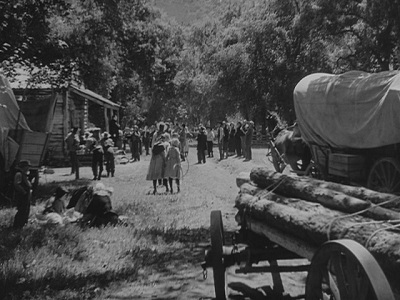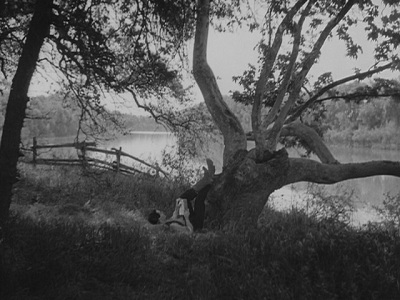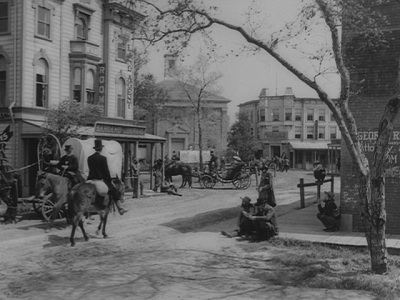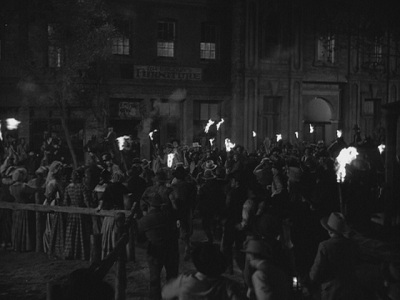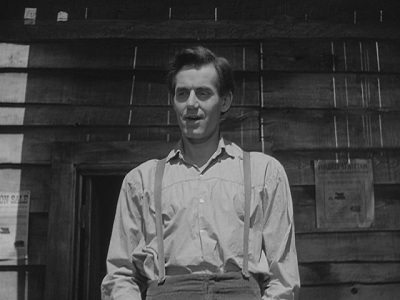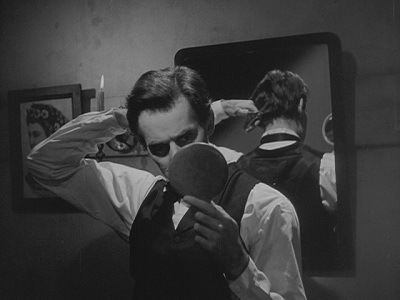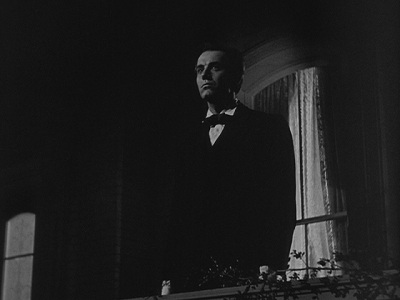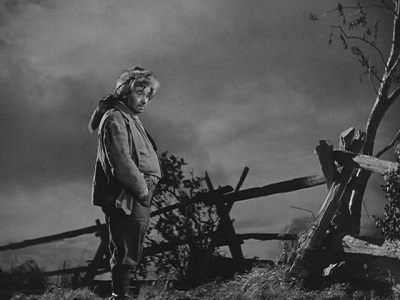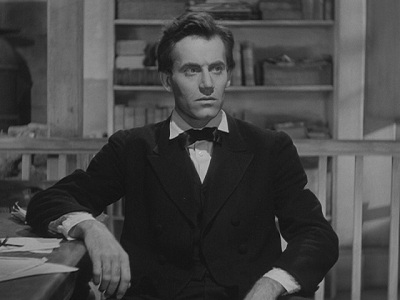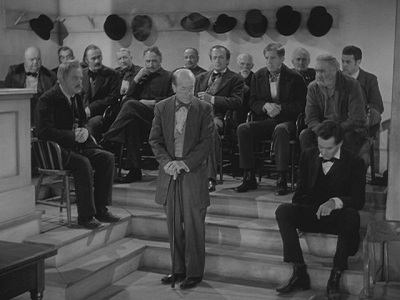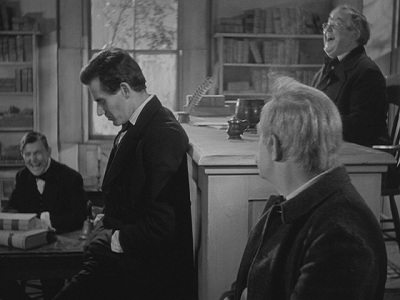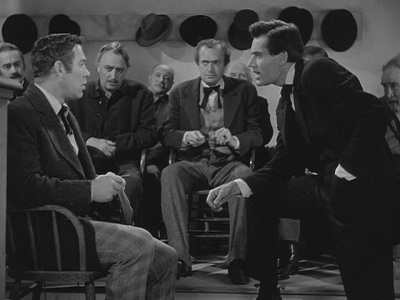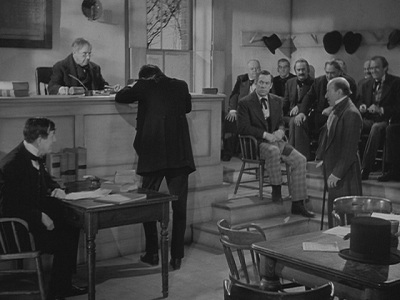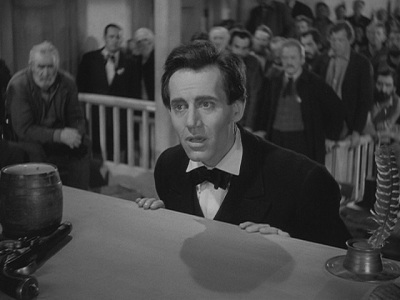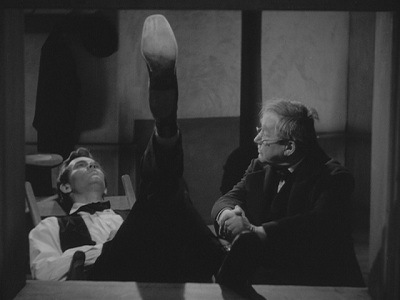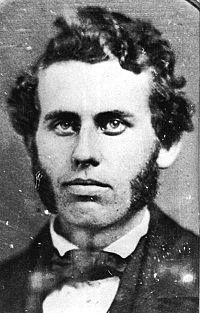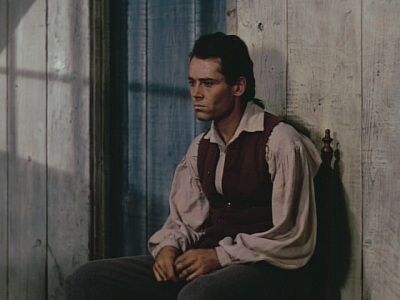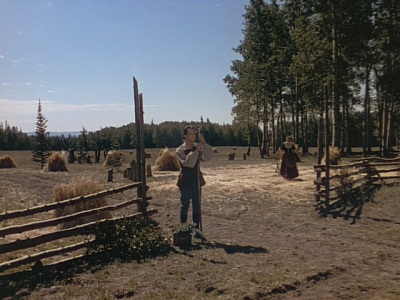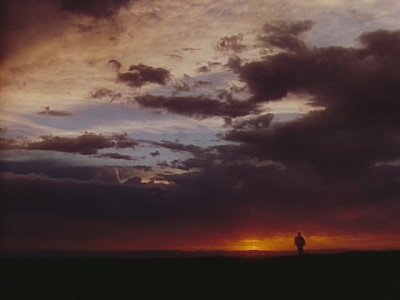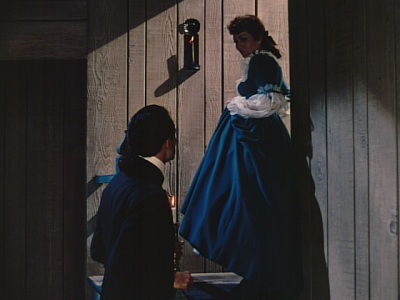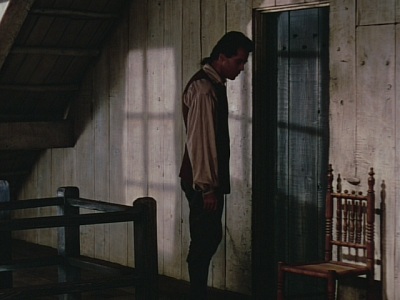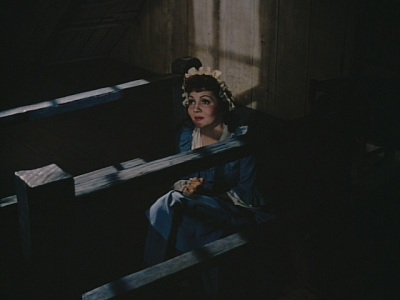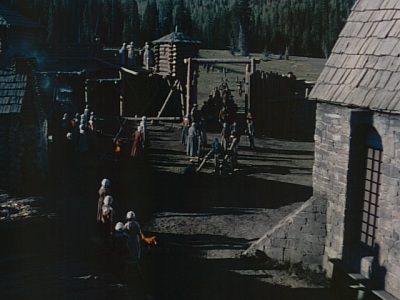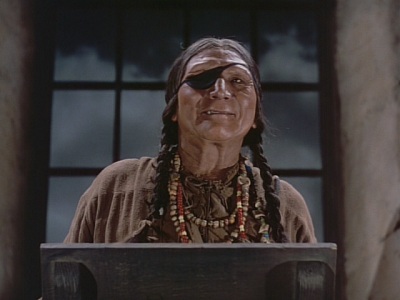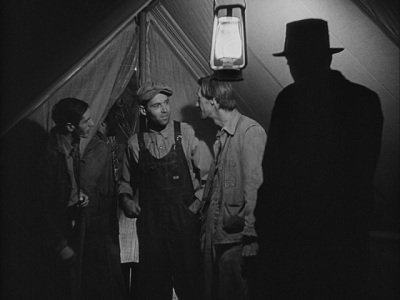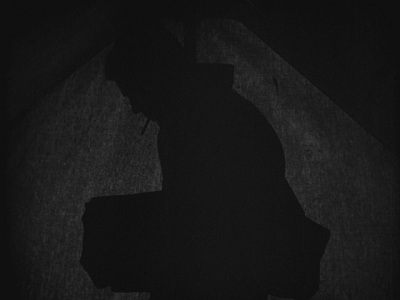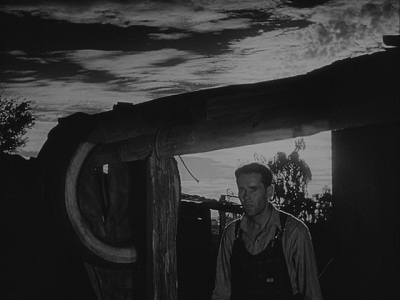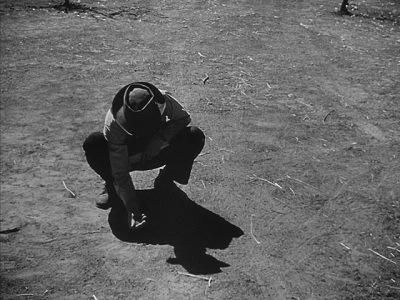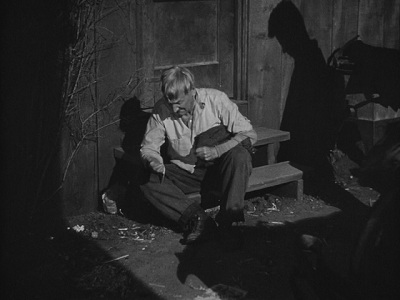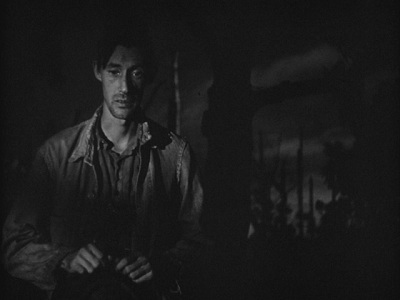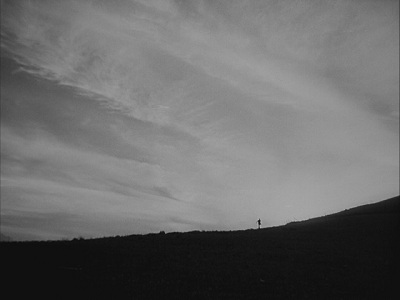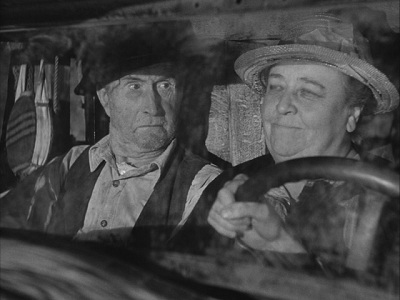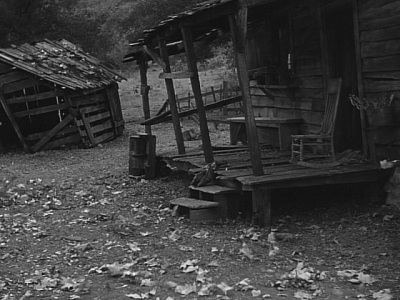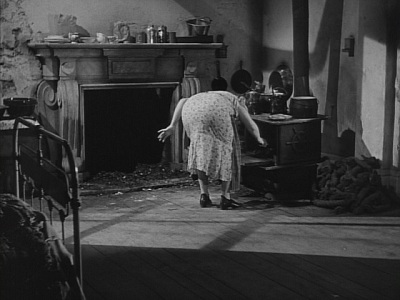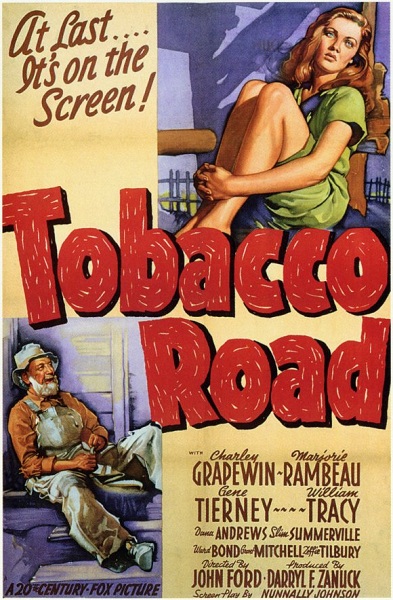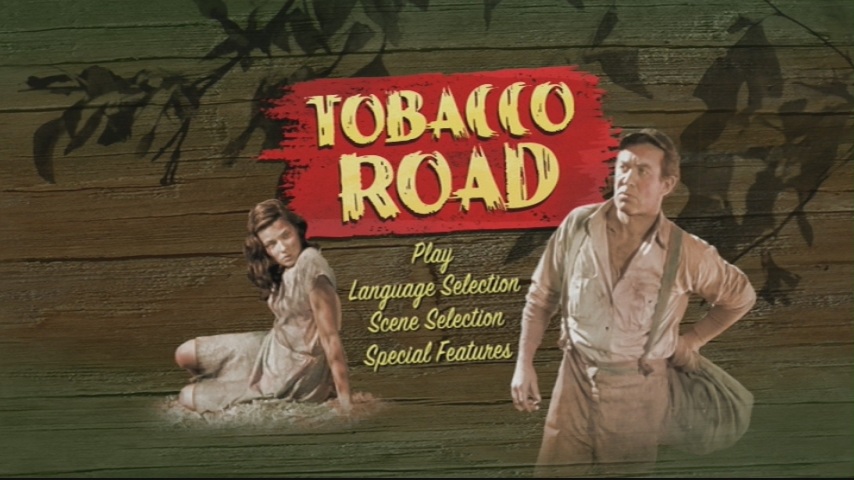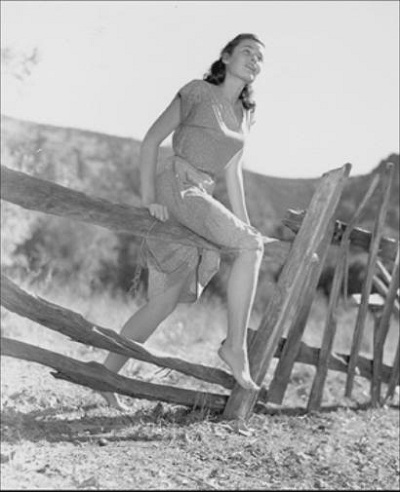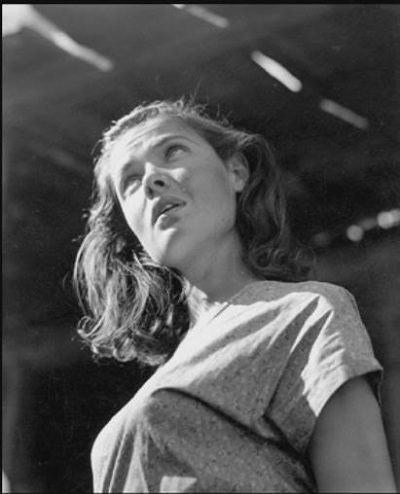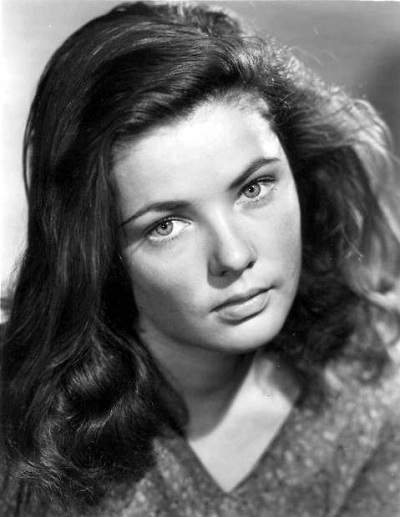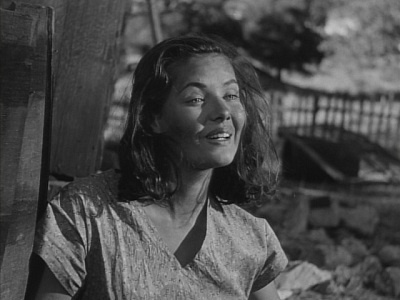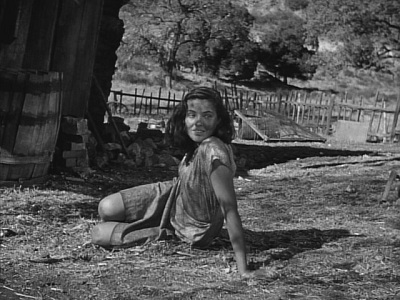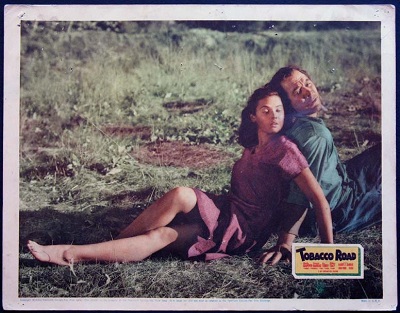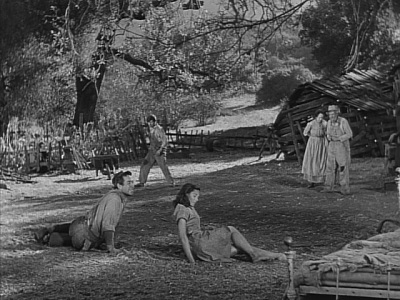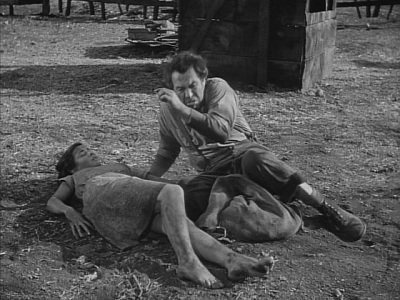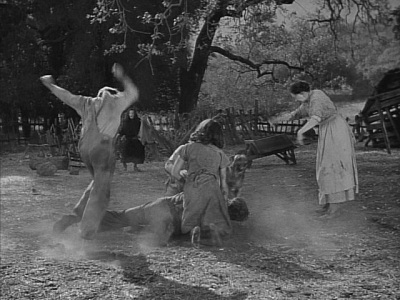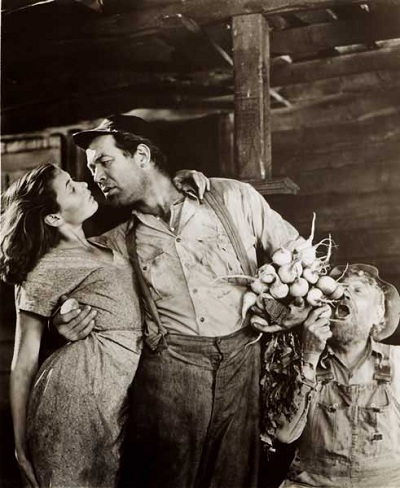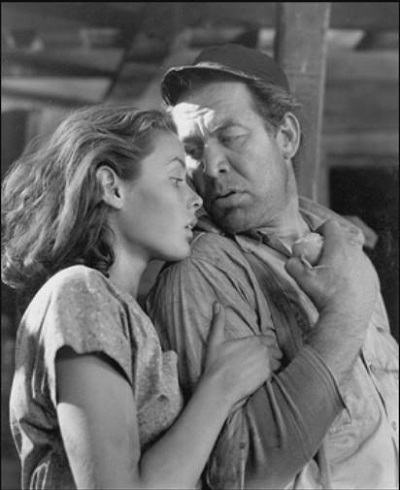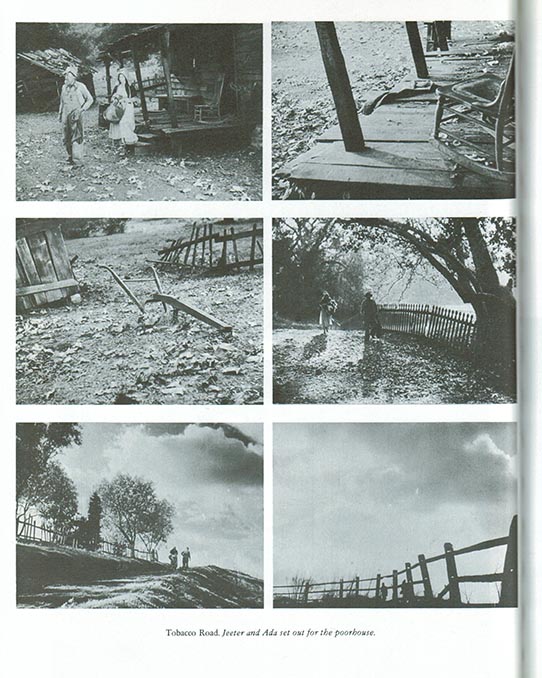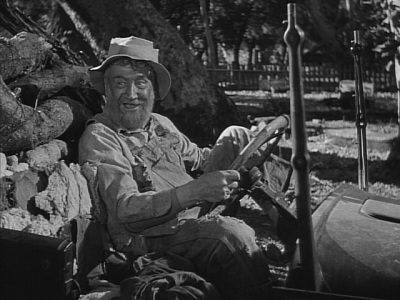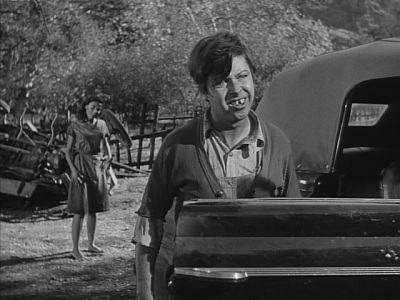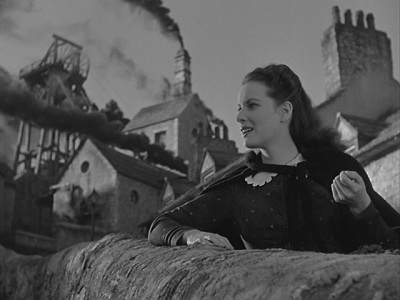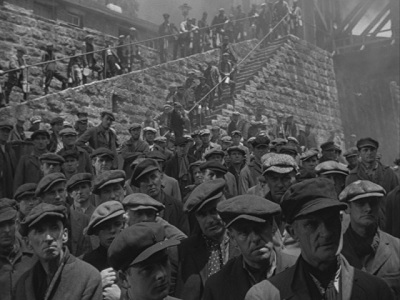Part 3c[1]
Introduction to Part 3c
[Young Mr Lincoln (1939)]
[Drums Along The Mohawk (1939)]
[The Grapes of Wrath (1940)]
Tobacco Road (1941)
– The question of mode
– The novel
– The play
– The screenplay
– Lindsay Anderson
– Not resolved
– Characters and their treatment
– Two wrong directions
– Addendum askew: The Primrose Path
– Honi soit qui mal y pense
[How Green Was My Valley (1941)]
This section is quite a bit longer than those that have gone before. The reason is that I have felt it necessary to write more about the “acknowledged classics” of this period because, taken together, they so clearly provide one of the most important contexts for understanding the one minor work, Tobacco Road, and set the tone for a great deal of Ford’s work for the rest of his career. At the same time you mustn’t expect finished or exhaustive analyses of the better known films, only somewhat expanded notes.
There is another context that may help to set the scene for what is to come.
Ford’s feature films from 1938 to 1941 generally increase in length.
1938
Four Men and a Prayer 85 minutes
Submarine Patrol 95 minutes
1939
Stagecoach 97 minutes
Young Mr Lincoln 101 minutes
Drums Along The Mohawk 103 minutes
1940
Grapes of Wrath 129 minutes
The Long Voyage Home 105 minutes
1941
Tobacco Road 84 minutes
How Green Was My Valley 118 minutes
However, since at least 1935 there had been a noticeable tendency for Ford’s features to get longer, probably in keeping with (1) a general trend for A-pictures to get longer, (2) his growing success as an A-picture director, and (3) Darryl Zanuck’s aspirations for prestige. What happens in the years between 1938 and 1941 is that the proportion of films longer than 100 minutes becomes larger (5/9).
The years from 1939 to 1941, Tag Gallagher perceptively observes, constitute “Ford’s prestige period” – which was also “very much a populist period” (165). I am going to try to address the two words, “prestige” and “populist”, at least indirectly, in most of what follows.
*****
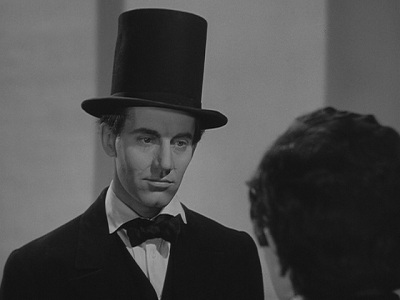
Young Mr Lincoln is a very tempting text. It seems that every second of the film has been designed to invite appreciation and discussion; and I expect that this is one of the reasons that it slips so easily into the “classic” or “masterpiece” category, with which I ought not be much concerned here. The disc in the Ford At Fox set is labelled “The Criterion Collection” and “disc one: the film”. Disc two, one imagines (correctly), must contain documentaries and interviews and other material related to the film, all designed to extend and enhance the experience, in the way of disc twos the world over. In view of all that, it is utterly amazing that there is no commentary on disc one.
But merely imagining disc two – or, indeed, a commentary for disc one – is all right because Young Mr Lincoln itself is made to set you dreaming. It is a veil behind which vague, suggestive shapes wave. History? Mythology? Politics? A culture’s psyche – or just another figuration of desire?
There’s a big element of kitsch in this, and sound, especially music, plays a big role in the film’s kitsch effect. I think that one of the most noticeable changes in Ford’s work for this “prestige period” is in the type and the amount of time devoted to music on the soundtrack.[2] In Young Mr Lincoln the music seems insistently present from the opening titles during which “Rally ‘Round the Flag, Boys” is sung by a womens’ choir with precise upperclass diction. There follows a section in which slow sentimental strings play a folk melody, and spruced-up folk music at least tinges the rest of the score. Moreover, in the “prologue” or pre-Springfield scenes the music seems to follow its own non-narrative, descriptive, diegetic line and the sound mix features music so prominently that at times it seems almost on a level with the dialogue.
This sound design is in keeping with the series of strikingly generic images that characterises the first half hour and more of the movie. Here are some of them:
Indeed, Young Mr Lincoln is stuffed with such images, like a Thanksgiving turkey. And they are, like Thanksgiving turkey, wonderfully flavourful, filling and always just a bit too much.
*
Some disturbances – subtexts?
Tag Gallagher – who has written, as usual, well and to the point on this film – claims that “no blacks appear in its 1830s Illinois” (184). But they do, if less prominently than in earlier Ford films. There are 2 African-American men (uncredited) marching in the Independence Day Parade holding a banner for the “War of 1812 Veterans”. Their images appear directly after we see Abe (Henry Fonda) as a spectator; they are followed by Sam Boone (Francis Ford) with a jug. There is a black servant (shown in a still in Gallagher’s book) in the Clinton house when Abe comes to the soiree where he dances disastrously with Mary Todd (Marjorie Weaver). The servant’s image initially directly follows Abe’s, and he is otherwise visually associated with Abe in other shots in the sequence. The point is that these fleeting images are easy to miss, the actors uncredited, and that their comparative invisibility is of a piece with the inoffensive kitsch of the whole – in spite of their visual association with the figure of Abe. I should point out that the period during which African-American actors were heavily promoted, and specifically the period of Lincoln Perry’s ascendency, was long gone by 1939 and it was undoubtedly no longer studio policy to feature black actors in many Fox films.
Lighting is a key element of Fonda’s appearance as Abe. Lincoln’s skull-like face tends to make many of the attempts to portray him onscreen throughout the years sort of creepy, starting at least with The Birth Of A Nation, and I have often thought that the white South must have seen that image of death as Lincoln’s principal aspect. This example of the same kind of imagery comes from the first sequence of the film.
One of the most striking instances of this figuration of Lincoln occurs in conjunction with the fleeting appearances of African-Americans mentioned above, as Abe gets ready to go to the Clinton’s soiree.
There is also an intriguing use of dark expressionist tonality for certain interior images of Abe. One of those shifts in tonality climaxes a scene with Mary Todd into which the river and the future are intermixed – and might even be said to be the climax of the first, largely contextual, part of the film.
“Normal” (if expressionist) tonality:
The climax of the scene:
*
Visions and what cannot be articulated
The very first sequence sets up a pattern of simplification in a sort of bucolic prologue but then, with ominous music, winter sets in, and Abe visits Ann’s grave in the snow. He talks to her (as Judge Priest talks to his dead wife at the graveside). Does Ford believe that Abe is doing anything other than talking to himself? (Abe stands up a stick so that her spirit may influence its fall but then says, “I wonder if I could have tipped it your way just a little?”).
Both Abe and Abigail Clay (Alice Brady) want to hold on to the past. Mary Todd, who is contrasted as much with Abigail as she is with Ann Rutledge (Pauline Moore) is, on the other hand, determined to break with the past (her class and region). She is the direction in which that stick, perhaps animated by Ann’s spirit, falls.
Abe on pie judging: “So it goes: first one, then the other”. Abe and Abigail Clay recognise that there are situations in which one or another side’s winning is not the best outcome. The judgement of Solomon is mandated far more often than Abe’s first reading of Blackstone’s Commentaries on the Laws of England suggests. (“By Jing, that’s all there is to it! Right and wrong!”, he exclaims). It turns but that Abe is, um, wrong about that because the law ensnares him and Abigail in a dilemma precisely about the difference between what is right and what is the law (in other words, not used in the film, what is due to God and what due to Caesar).
Abigail cannot tell Abe which of her sons did the murder. She cannot speak the words.
Abigail: I can’t. Be just like choosin’ between ’em.
Abe: “Lot of people like to see those boys hung.
Abigail: I know, but I just can’t
…
Abe: Naw, I don’t reckon you can.
It is not that she does not know (or think she knows), but that so long as she does not reveal what she knows her two sons are equally guilty and equally innocent – that is, they are in limbo, in a liminal state. What this does is merely to keep them in the state they occupy existentially between their arrest and the verdict. It does not defray the verdict: it is merely wishful. That is, it repeats the state that we leave Abe in during the pie judging. In this fiction we need never know the result of the pie judging – but we probably believe that there was finally a result. And in this fiction there must be a verdict for the trial.
Apparently Abe cannot believe that the prosecution would call Abigail Clay. Apparently Abe’s reverence for motherhood is what has betrayed him here. Ford understands this and applauds it, but remains at a distance, allowing us to be surprised by Abe’s surprise. Just as in the story of the film itself, Ford shows “the truth” rather than “what’s right”. This surely must be because judgment must involve the truth and because in the universe he makes in his films Ford can make the right and the true congruent.
Felder, the prosecutor (Donald Meek), tells Abigail she must “speak the truth”. Abigail: “I can’t” (see above). Abe: “I may not know so much of law, Mr Felder, but I know what’s right and what’s wrong”. Compare this with his first reading of Blackstone and, of course, with peasant/visionary morality – because the “peasant cinema” identified by Bertrand Tavernier seems to have coloured all of Ford’s films from this period.[3]
Gallagher wants to make a distinction between “character” and knowing what’s right and wrong – but I am not sure that the film does this. Certainly it makes a distinction between “the law”, in the sense of codified and more or less thoughtless system of “rights and wrongs”, and knowing what’s right and wrong. Abe finds he does know what’s right and wrong, and (because of this?) he is vouchsafed a vision of the truth of the matter. He sees, he imagines, what actually happened, what must have happened, in the murder; he does not deduce (much less prove) it – which is surely why he recites it all to John Palmer Cass (Ward Bond) while the later is outside the space of the court.
*
The passage from peasantry
Gallagher says “The thrust in Young Mr Lincoln is passage”, a transition from somewhere (death? life?) to somewhere else: “one world to another, youth to age, innocence to wisdom, man to monument” (195). This is liminality, a state of in-between. Cahiers du cinéma‘s inability to recognise a liminal state seriously vitiates the journal’s famous attempt at a deep political analysis of the film.[4] That is, in a liminal state all is in suspension, not yet properly formed – thus what happens in such a state does not mean what it would mean were it to happen in a non-liminal state: it is a kind of experiment or rehearsal – perhaps a kind of populism. Time is a key factor in such situations, even if history is not.
Gallagher’s summary of Lincoln: “Lincoln is a paradigm of the Fordian hero: celibate and alone, possessed of higher knowledge to mediate intolerance and proclaim a new testament, even by violence or cheating. Judge and priest, a sacrifice like Christ, he reunites a family and walks away at the end.” (198). (But of course he does not walk away from, but a little way after, the Clay family).
History acts as validation for heroes at least. As seems reasonable for a liminal state, the film shows a past that is always prefiguring the present and the future. The reason for the past seems to be to prepare for the (better?) future. Ad hoc ergo propter hoc. If this is “a hero effect”, it would seem that heroes must cast some kind of quasi-retrospective influence and that history is determined, but I think it is simply a formal convention of Ford’s kind of populist/legendary fiction. (A formal convention that packs a lot of persuasive power.)
The hero and the mob (crowd) are bound in a terrible union. If African-Americans are the invisible subject of lynching, revolution is the invisible driver of mobs. Mary Todd knows this. She calls the lynching attempt “the recent deplorable uprising” in the invitation to the dance that she sends to Abe.
Abe’s selection of jurors is based on his vision (which Gallagher might call his character). He accepts the drunken Sam Boone because of what he perceives as his honesty, just as he accepts the honest man who dislikes the Clay boys. Honesty is a stellar peasant virtue; and surely, first of all, as a kind of reassuring underlining of his heroism, Abe is a peasant or, perhaps more accurately, he comes of peasant stock. Consider his chosen musical instrument, the “Jew’s harp” and the song he plays on it (“Dixie”).
Here is some more evidence of the invisible peasant soil of this film.
Abe on Abigail in court: “Look at her. She’s just a simple, ordinary countrywoman. She can’t even write her own name.” … “I’ve seen hundreds of women just like her, workin’ in the fields, kitchens, hoverin’ over some … sick and helpless child. Women who say little but do much, who ask for nothin’ and give all.” That is, she is a common person, a peasant, of the land. (However, Alice Brady’s cultivated theatrical accent suggests that Abe’s characterisation may not be entirely accurate).
And there is Efe Turner (Eddie Collins), a Sancho Panza-like figure whom Abe leaves behind at the climax of the film when he walks up the next hill over which the Clay family has recently disappeared.
Many have suggested that Abe is walking toward his destiny, his future, when he walks up the hill. It is not at all inappropriate to point out that when Young Mr Lincoln was made the world itself was in a liminal state, awaiting a war. This too is where Abe is walking.
And if Ford’s cinema is a “peasant cinema” it is so in the same sense that Molière’s plays are “peasant theatre”. Certain aspects of what the author believes to be peasant morality are valorised in them, but the author himself is far from adopting a peasant’s point of view. In this case I believe that the author and the main character share a certain distance from what they seem to be endorsing most wholeheartedly.
*
Fonda’s performance, Abe’s performance
Abe is a performer. Not only does he tell stories and crack jokes, he also plays a musical instrument of sorts. The line between Fonda, the actor performing Abe, and Abe, the actant performing Abe, gets blurred, just as it does in the Will Rogers movies. At one point, Gallagher says something about Fonda’s grace at the soiree (185), and by this he must mean a grace that appears in spite of what is called for by the story – that is a grace that belongs to Fonda, not to Abe – for one of the points of the scene is that Abe is not graceful on the dance floor.
Fonda performs in the court, often very much like Will Rogers in Judge Priest. Stephen Douglas (Milburn Stone) explicitly acknowledges this quality of Lincoln’s (“Mr Lincoln is a great story-teller. Like all such actors, he revels in boisterous applause.”). Consider these stills in the light of the simultaneous performances of Abe, Fonda – and Ford.
*
Honi soit qui mal y pense
*
Quasi-addendum
This is not a photograph of Henry Fonda playing Abe Lincoln. It is a (rather peculiar) photograph of the man who owned Ford’s Theatre, where Lincoln was shot in 1865. I read the following paragraphs on this man thinking of Young Mr Lincoln and The Prisoner of Shark Island, and John Ford of Maine as well as John Ford of Maryland, and, of course, of the figure of Abraham Lincoln.
[John Thompson] Ford was the manager of this highly successful theatre [Ford’s Theatre] at the time of the assassination of President Abraham Lincoln. He was a good friend of Lincoln’s assassin John Wilkes Booth, a famous actor. Ford drew further suspicion upon himself by being in Richmond, Virginia, at the time of the assassination on 14 April 1865. Up until April 2, 1865, Richmond had been the capital of the just defeated Confederate States of America and a center of anti-Lincoln conspiracies.|
An order was issued for Ford’s arrest and, on April 18, Ford was arrested at his Baltimore home which he had reached in the interim. His brothers James and Harry Clay Ford were thrown into prison along with him. John Ford complained of the effect his incarceration would have on his business and family, and offered to help with the investigation, but Secretary of War Edwin M. Stanton made no reply to his two letters. After thirty-nine days, the brothers were finally fully exonerated and set free since there was no evidence of their complicity in the crime. The theater was seized by the government and Ford was paid $100,000 for it by Congress. Due to the treatment accorded to him following the assassination, Ford remained bitter toward the United States Government for decades. (Wikipedia)
I believe that it is not likely that John Ford, the person with whom I once exchanged some sentences bearing on how one reads the past, would have considered the similarity of his name and the name of the owner of Ford’s Theatre mere coincidence.
*****
[Drums Along The Mohawk (1939)]
Joseph McBride considers the film simplistic and racist. In a short article on Ford which appeared in the same issue of Présence du cinéma as Bertrand Tavernier’s piece on Ford’s “peasant cinema”, Alain Ferrari, interestingly, compares Ford’s treatment of the story to a nightmare.[5]
There is a commentary on the disc, a very interesting one. It is in the form of a dialogue between Julie Kirgo and Nick Redman, whose work in history and film history has mainly resulted in films themselves. Both were involved with Becoming John Ford, the documentary packaged with the Ford At Fox set. Kirgo is credited as the writer of that film, as well as an associate producer and Redman as the director and a producer.
Colour is, in point of fact, quite important in the impression that this film makes.
Significance of “artistic” cinematography during this “populist prestige” period of Ford’s work. Long shots and extra long shots in Drums Along the Mohawk. This seems like a film of long shots where the eye is constantly being drawn to the centre and the back of the image, away toward the horizon. So much seems to be happening behind or around those in the foreground or middle distance.
The silhouettes in the running sequence are now iconic.
Gallagher says this is Ford’s “least expressionistic [film] since talkies began” (199). But there is some striking “expressionism” in the film, as evidenced above, and in the stills below.
These last two shots also suggests the film’s affective use of thresholds (including stairs, vehicles and other means of transmission), sites of turbulent emotion, of upset, passage. Very often the long shots of the film also depict passage – not only in images of roads, actual or suggested, or in movement within the frame, but simply in the distance, temporal and physical and narrative, between foreground and background: a distance the film is sooner or later bound to span. In terms I have used before, this is part of a strategy of folding as distinct from cutting, as images overlay one another rather than are separated from one another. These long shots put viewers in the position of looking in depth and having to look twice.
Gallagher: “[Drums Along the Mohawk] sketches a gloomy series of events undergone by pioneer settlers in New York’s Mohawk Valley, 1776-1781. The land is work; Indians attack periodically; farmhouses and crops are burnt: children are born, men march off to fight the British and die. But the land is virgin, the people young, the air suffused with freshness, the gloom something to be brushed aside” (198). This outline omits that the hostile Indians are shown from the first to be directed by a British agitator (John Carradine). Lana’s (Claudette Colbert) fear is apparent in the very first shot of the film, and has its culmination when she kills the Indian who menaces the group she is protecting in one of the climactic scenes. The gloom of war/destruction/fire is never brushed aside: it suffuses the entire film – a nightmare, as Ferrari says.
But, most telling of all in the context of the films surveyed in this section, the community always returns to the land it has temporarily left. If we are being shown a community in transition, the goal of their journey is never in any doubt. It is not strictly speaking correct to call the characters in this film “peasants” when they are in context members of aspirant rural middle class (farmers, artisans, merchants), yet at the same time they are clearly intended to embody virtues commonly attributed to peasants: tenacity, hard work, a feeling for the land, simple morality, the wisdom of experience, lusty exuberance. Peasant references abound: the cow attached to the wagon that takes Gil (Henry Fonda) and Lana to the country, farms, crops, “documentary” coverage of certain work practices, the desire for land of one’s own. Lana and Gil Martin seem like younger versions of the Adam and Abigail Clay we see in the beginning of Young Mr Lincoln.
The Big Issue: History (Gallagher cites it, and the commentary concentrates on it) vs Spectacle (production design, etc.). The commentary actually treats the film as though it intended to faithfully represent the events of (some kind of) history: the commentators talk mostly about the actual events, people, etc. upon which the fiction is “based” – or, as I would prefer, out of which it grew.
Kirgo, for example, remarks at one point of the characters in the film, “These are people who are not yet Americans”. But these characters are not “people” at all, never were and never will be – and surely the point of the film is precisely that they are “Americans” even if they do not know it. The actors (the actual people) on the screen come from various countries. And it is also the case that it is virtually impossible to say when the characters/people Kirgo intends to refer to – the real people of the time and place fictionalised in the film – did become Americans: whether, for example, the motives for their rebellion made them Americans before the fact or whether Indians and African-Americans were made Americans in any significant way by the success of the revolution.
The point is not that Kirgo has made a silly remark but that the very “historical reality” of such an unremarkable, commonplace perception as the relation of “people” in general to “Americans” in particular resembles fiction far more than it does anything that one usually thinks of as history.
An apparent digression is, it seems to me, actually a telling response to precisely the issue of what is history and what fiction that the film overtly presents:
Redman: That is one of the true tragedies of history, isn’t it? That everyone in the end breaks their …
Kirgo: Breaks their solemn promises and treaties. Yes. Absolutely.
That is, history always betrays the fictions made from it, just as first Gil, then the man of God (Arthur Shields), and finally Lana, kills. Or just as hot water, like so much else in this film, is deployed twice: first for birth, about which Adam (Ward Bond) remarks, “I don’t know why we gotta have so much hot water when babies are born anyhow”, and then in the climactic battle when the women use it to save Adam and others briefly from the Indian’s final onslaught.
The explicit thematic of the origins of the United States surely has much to do with the film’s status as a middlebrow “classic”. The commentary explicitly discusses “patriotism” and offers the telling definition: “what your country stands for” – but this, of course, is precisely what history in the sense of actual events and people cannot show. Only a fiction can show what a country stands for because what a country stands for is a matter of the interpretation of events and personalities, not What Really Happened but What It Really Meant.
Gallagher: “The film’s siege is fictitious”. In a significant sense, this is the very point of the film and of the book from which it was taken (a historical fiction aimed at teenagers as much as at adults)[6] . Indeed, the film is very, very upfront about its artifice while emphasising “documentary” passages of work and other aspects of everyday life. The production design and sheer beauty of the film is deliberately enhanced. This is “expressionism” too, in the broader sense of deliberate and noticeable (visual) artifice that intrudes on a “realistic” experience.
Consider the evocation of war through dialogue and complete suppression of sounds of pain in the nursing scene. Initially the ambient sound level is rather high, as Gil is brought into the room along with other soldiers and there is much rustling and sound of movement (but no words, groans, or other oral sounds). But as the camera moves in, these background sounds disappear and only Fonda’s and Colbert’s voices are be heard. This effect is crucial and must have been achieved by the sound crew working in pre-planned synchronisation with the camera crew while the scene was being shot.
Zanuck had been growing progressively more frantic as the date for the troupe’s return from Utah drew near and Ford, already over budget and behind schedule, made no preparations for this huge battle — it had been scheduled for three weeks of shooting. He badgered Ford daily with telegrams. Then one day Ford replied: they were caught up, within budget, and the battle had been filmed that morning. What had happened was that Ford, out of a clear blue sky, had turned to Henry Fonda (Gil): “Henry, I have to shoot a battle scene that I don’t want. I had a better idea today. You’ve studied the script and your role, you probably know more about the battle than I do. Sit down and lean against this wall.” With the camera aimed at Fonda, Ford fired a series of questions: “So, Henry, how did the battle begin?” And Fonda replied, making up an account. “And Peter? What happened to Peter?” asked Ford; or, “What was it like to have killed that man, after seeing John die?” And Fonda went on improvising, giving a virtual psychoanalysis of the battle. “Cut,” called Ford, and told the editors: “Cut out my questions and use it as it is.” One long take.(280)
This is Gallagher’s summary of Robert Parrish’s account as published in the French journal, Présence du cinéma[7] .
Satisfying as Parrish’s anecdote is, what happens on the screen casts some doubt on its accuracy as history. Ford does not appear to be feeding questions to Fonda off camera; for one thing Colbert is quietly but franticly talking to Fonda at every break in his monologue. Still, the scene is “one long take”, and a virtuoso take at that, broken only at one point by cutaways to three short shots showing another part of the house where General Herkimer’s leg is amputated to the accompaniment of hushed dialogue and a soft grunt from the General (Roger Imhof).
The on disc commentary by Kirgo tells a slightly different story about the circumstances of the scene and expands on its virtuosity.
The battle was a scene [in the script], and Ford had actually prepared to shoot the battle scene. But evidently, possibly at one of the campfire events that he would habitually have on location, he and Henry Fonda were talking about the scene and Henry Fonda began to extemporanise [sic] about the battle, what it must have been like, what Gil must have seen. And Ford said, “I’m not shooting the battle; let’s do this: you tell the story of the battle”. It’s an amazingly effective scene, as we’ll see. This I think is such brilliant staging. You are focussed on Henry Fonda and Claudette Colbert as she tries to dress his wound and he tells the story of the battle, but meanwhile there is all kinds of action going on around them. She is busy with trying to dress his wounds, make him more comfortable: save his life. And meanwhile there are other women in the background doing the same for other soldiers. And it just … and there’s the firelight … and he is telling this horrific story of the battle, which comes very much alive; and he tells it in a way that is very characteristically Fondian, if I could use that word (if it is a word). He is not screaming it out; he is not being all histrionic about it. He is just telling the story.
It would seem that Fonda ought to be given credit for the harrowing story as well as its performance. It is one of the most effective anti-war scenes I know, which does not mean that Ford was anti-war, only that he was, like Fonda, a vehicle for whatever made the drama work.
False/true mother: the active/activist widow McKlennan (Edna May Oliver).
Although the film begins with Lana’s point of view, it gradually broadens to include, first, the couple’s point of view, and ultimately that of the entire community.
Charges of “racism” in this film seem to derive from the portrayal of the savage behaviour of the hostile Indians and the apparently patronising portrayal of Blue Black (Chief John Big Tree). However, this still goes a long way towards questioning such a swift judgement.
Honi soit qui mal y pense.
Blue Black is announcing that he has killed the British villain who was behind the Indian attacks. Thanks to Nick Redman and Julie Kirgo for confirming my perception of the positive nature of this image in their commentary. What they do not say and I will is that it is really hard to think of the man who directed this shot, which is a doppelganger image of himself, as a benighted racist. I bet that is Ford’s own eye-patch.
Although I have used Kirgo and Redman as straw figures to stand for a school of criticism I clearly think is misdirected I want to stress that the commentary track they have done is interesting, sensitive and well-informed. It addresses issues which most people will want to have addressed, which is not a bad thing, and it is intelligent and observant – which has not been my experience of most commentary tracks. You ought to look at the film at least once with their commentary.
*****
The two-sided disc which is devoted to The Grapes of Wrath contains a striking digital restoration that does visibly improve on the restoration of the film material as well as a commentary track. The B-side of the disc includes a 45 minute account of Darryl Zanuck’s career which provides a Zanuck context for the Ford/Fox films from Steamboat round the Bend to What Price Glory.
*
Communism
The commentary on The Grapes of Wrath is by Joseph McBride, who has been cited in these pages several times already, and Susan Shillinglaw, a professor of English who is one of the leading scholars of John Steinbeck and his writing.
Their commentary is about film/novel relations (in case you did not know, the book and the film are quite close) and about reportage – that is, how both the book and the film represent “the reality” of their topic. In this latter aspect it is much like the Drums Along the Mohawk commentary. This is a particular critical practice and it is not one that I follow most of the time. In this case it rather has the effect of making Ford’s film into a copy of a copy (a film of a book about a reality), which is unfortunate. And, despite their praise for Ford’s work, neither of the commentators deals with the direction of any scene in detail, as Julie Kirgo does during Drums Along the Mohawk. At the same time, as I tried to suggest in what I wrote about Drums Along the Mohawk, a commentary which treats a film as a medium for representing something else, like history or reality, can add considerable interest to what you are looking at – and this one does that even better than Kirgo and Redman. For example, there is a difference of opinion between Shillinglaw and McBride on Steinbeck’s later “conservatism”, which takes up rather a lot of time, but is extremely interesting for the tension between the commentators that it generates, and because “anti-communism” figures so strongly in the later political attitudes of both Ford and Steinbeck. Although neither McBride nor Shillinglaw says so, the point at issue comes down to the circumstance that there is actually not now, nor was there in the thirties, a consensus on what constitutes “left” and “right”, “liberal” and “conservative”, much less where “communism” figures in the debate.
The issue is not so irrelevant as it may at first seem today. Everyone these days agrees that The Grapes of Wrath is unusual for a Hollywood movie in that it is unapologetically tendentious and leftwing. But everyone also agrees that not all tendentiously left art produced in the US during the thirties was “communist” in the sense that it was sponsored or directed by the international Communist movement. The latter half of the thirties was a period in which the understanding of what constituted “communist” art broadened considerably, as a result of the Communist International’s 1934 Popular Front initiative, which advocated cooperation with any group opposed to fascism. John Steinbeck, and Erskine Caldwell (author of Tobacco Road) were among the American novelists whose work was identified with the Popular Front.
It was surprising even at the time that Ford’s film for Twentieth-Century Fox preserved so much of the tendentiousness (or just preachiness) of the novel. But no one nowadays thinks that John Steinbeck or John Ford (much less Darryl Zanuck) were taking directions from the Communist Party, and I don’t think that was the case either. What interests me is that the tendentiousness in the form and substance of the film are, it seems to me, pretty close to what can be found in Soviet – that is, definitely communist – films in the thirties.
Why would that be the case? First let me sketch the peasant connection for Soviet film.
I have already had occasion to mention Sergei Eisenstein’s sojourn in the Americas (1930-32). Eisenstein came to Hollywood the year after he had completed The Old and the New (1929) and the project which occupied him most in the years immediately after his return to the USSR was the unreleased Bezhin Meadow. Both of these films were about peasant life in the Soviet Union. The “Mexican film” on which Eisenstein worked during the latter part of his sojourn was about the relation of the Mexican peasantry to the impulse to revolution in Mexico. (To round out the connection between Eisenstein and Ford’s “cycle” of peasant films, in 1945 the Soviet director and theorist wrote an extremely perceptive and sympathetic essay on Young Mr Lincoln which discusses the figure of Abe in that film in terms of certain peasant-like attributes – see Note 3 below).
The peasant subjects of Eisenstein’s films were by no means unusual in the Soviet cinema of the thirties. The peasantry was an explicit concern of Soviet policy in the twenties and thirties, and Soviet films on the topic were overtly tendentious. However, for the Soviet government of the period the peasant class was the product of a feudal regime; and peasants, unlike workers, tended to be depicted as inherently violent and small-minded, as well as too attached to private ownership. The villains of such movies were kulaks, “rich peasants”, who shared the ugly characteristics of peasants in general to which were added greed and lust, as well as the despotic tendencies of the bourgeoisie. Peasant heroes, on the other hand, were visionaries (not unlike Tom Joad) whose ideas came to transcend their historically determined class situation, and who often found themselves at odds with that class even when their efforts were directed towards its betterment. A lot of this seems to be floating around in both the book and the movie of The Grapes of Wrath.
Consider also Peter Kenez’s summary and extension of Katerina Clark’s analysis of the Soviet novel:
…a socialist realist novel is always a Bildungsroman, that is, it is about the acquisition of consciousness. In the process of fulfilling a task, the hero, under the tutelage of a seasoned Party worker, acquires an increased understanding of himself, the world around him, the tasks of building communism, class struggle and the need for vigilance. Indeed, the same masterplot can be found in films …
Socialist realist films included three stock figures with depressing regularity: the Party leader, the simple person, and the enemy. The Party leader was almost always male, ascetic … unencumbered by a family or love affairs. The simple person could be male or female … sexual relations were always chaste … the enemy, whose function was to wreck and destroy what the Communists were building was always a male … [8]
If Clark’s and Kenez’s analyses suggest the simplicity of folk tales, it is not a coincidence. “Socialist realism” was explicitly linked to the virtues of folk traditions. Moreover, the “documentary” elements of both versions of The Grapes of Wrath were part of a conscious attempt to create an accurate figure of the “the people” (the folk) in words and images, and to be guided by that figure in determining how to think and act. The “natural” and “innocent” qualities of such a figure were a distillation of the “natural” and “innocent” qualities of traditional folkloric peasant figures, just as less admirable qualities of traditional peasant figures were represented in Soviet films of the period, all in the name of a fundamentally accurate documentation of reality that transcended mere reproduction. And the emphasis on money, prices, wages, work and ownership as mechanisms of control and liberation critically affecting the lives of rural characters were equally derived from and dependent on the desire to depict things “as they really are”.
Soviet films from the thirties in which peasant ideas and culture play a key role include Earth (Dovshenko 1930), Chapayev (1934), Peasants (Ermler 1935), Happiness (Medvedkin 1935), and The Childhood of Maxim Gorky (Donskoi 1938).
To complicate matters, films like Chapayev strongly evoke Ford’s work. There is obviously a kinship between what Ford appears to be doing by valorising “the common man” in stories that depend upon conventional characters and conventional narrative structures and what Soviet film makers were doing in “socialist realist” films like Chapayev and The Childhood of Maxim Gorky. I believe that Ford’s films influenced Soviet socialist realist films as well as the other way around.
However, the elements of Soviet style and theme in/of the film and the book of The Grapes of Wrath make an awkward fit with the shifting alliances of the USSR during the period between the book’s publication (April 1939)) and the film’s release (January 1940). In August of 1939 the Soviet Union signed a treaty of non-aggression with Nazi Germany, effectively bringing the Popular Front against fascism to an end.[9] This meant that the film premiered in an atmosphere in which the non-communist left tended to feel it had been used and betrayed by the Comintern. The positive references to “reds” in the book and film now pointed, however distantly, to an ally of Germany, which had invaded Poland in September, 1939.
This can’t have been a comfortable position for either Steinbeck or Ford, who appeared at the very least to have used forms and ideas prescribed by the Soviet Union to depict injustice and oppression in the Unites States – and surely this circumstance accounts in some measure for the strong anti-communist stand both were to take after the war. In Ford’s case, his own somewhat prescient military activities suggest he may have deliberately and consciously taken an (unvoiced and private) stand against the Nazi-Soviet Pact.
In 1939, according to Gallagher, Ford began training a group that would become his Office of Strategic Services unit during WW2: the Field Photographic Branch (234-235). That is, in 1939 he was anticipating a war in which he wanted to play a part, not supporting any sort of appeasement urged by communists or anyone else. In September 1941, after the German invasion of the Soviet Union but before Pearl Harbour, the unit was ordered to Washington where it was formally adopted into “Wild Bill” Donovan’s spying operation; and it remained a part of the OSS throughout the war. It intrigues me that Ford was in the OSS, in a sense acting as Tom Joad says he will act when he heads underground in the climax of The Grapes of Wrath; and I have to believe that Ford’s service in the OSS had something to do with the extremely light treatment he received at the hands of the House Un-American Activities Committee during its notorious postwar Hollywood witch hunt.
But the most instructive lesson I take from the overtly Soviet content and style of the film of The Grapes of Wrath is that HUAC was not actually interested in whether Hollywood had been serving up communism in its movies at all. If it had been it would have condemned Ford (and Zanuck), among others, for The Grapes of Wrath, among others. Instead it was interested in catching communists no matter what they had, or had not, done in the movies. HUAC never for a moment really believed that “communist propaganda” was potent, but it did believe that communist people were bad in some kind of indefinable way. And, I think, this is the belief that Ford and Steinbeck came to share as well. They knew that they had not (permanently) caught any disease from their relations with communism, but they were convinced that others must have.
Which is to say, Ford and Steinbeck felt they knew better, were better, than others; they had been inoculated to recognise a truth that others could not. In that of course, they recall such figures as Abraham Lincoln and Tom Joad, representatives of the common people who are not common people themselves. It is not outrageous to think of such an attitude as rightwing – meaning in this instance quasi-fascist – populism. It has its Stalinist counterpart in Soviet culture, and is expressed forcefully in the work of the best known Soviet directors of the thirties.
*
The Shadow
The shadow of communism is actually represented in the film, although neither McBride nor Shillinglaw mentions it when it appears:
We never see this shadow’s face nor hear it speak. It is there in the foreground during Tom’s meeting with the strikers which precedes Casy’s murder.
Ford – or the film – does not ignore the implications of this figure, as this still of Tom’s shadow from the sequence of his departure suggests:
I would be more justified in calling this repeated figure “the shadow of communism”, if only anyone had cited it as evidence of Ford’s uneasiness with the leftist tendencies in the film. As it is, the shadow may only be a way of fore … um … shadowing what is to become of Tom. Perhaps it ought to be called “the shadow militant” or again, “the fugitive”.
*
American radicalism
Ford has said that he was interested in The Grapes of Wrath partly because the plight of the Okies reminded him of the Irish. McBride, in his commentary, draws a parallel between the Okies and African-Americans forced to sit in the special “coloured” sections of movie theatres, and Shillinglaw then extends the parallel to the migrant Mexican farm workers in the past and present southwestern United States. This series of equivalences suggests a different radical line, one more surely linked to the radical cultures of the United States than to the Soviet Union, where minority groups and ethnic differences did not play a great part in defining Soviet communism.
The Grapes of Wrath, like the Soviet films mentioned above, is explicitly concerned with the movement of peasants, rural farmers, to (or towards) a different status. However, in The Grapes of Wrath those who most resemble traditional agrarian peasants in their attachment to the land are literally left behind in that movement, and those who leave the land seem destined to live in a state of perpetual migration.
Muley (Eddie Quinlan), who appears when Tom Joad and Casy (John Carradine) are looking for Tom’s father, simply will not leave the area which contains his farm.
Muley and the land:
Grampa Joad (Charlie Grapewin) must be sedated with alcohol to get him to leave.
Grampa and the land:
Later he dies by the side of the road grasping another handful of dirt. The association of the gesture of handling the soil with the idea of depletion is not found so often in Soviet films as it is in American culture of the thirties, when the “dustbowl” was as prominent a symbol of the Depression as the stock market crash.
In The Cultural Front, Michael Denning uses The Grapes of Wrath as an example of one of the most effective and lasting popular “myths” created by the American left in the thirties.[10]
[T]he best-known Popular Front genre is probably the “grapes of wrath,” the narrative of the migrant agricultural workers in California. Indeed, the “Okie exodus,” the tale of southwestern farmers traveling out of the drought-ridden Dust Bowl of Oklahoma, Arkansas, Texas, and Missouri to California remains one of the most striking examples of Popular Front narrative becoming part of American mass culture . . . The story came to national attention with The Grapes of Wrath: John Steinbeck’s novel was a national best seller in the spring and summer of 1939 and was made into a film by Twentieth Century Fox, opening in January 1940. (259)
Denning traces the lineage of this particular narrative from historical events beginning in 1933 through Dorothea Lange’s photographs, which were first published in 1935, to Pare Lorentz’s The Plow that Broke the Plains (1936), to the publication of Steinbeck’s novel in 1939 and the film in 1940 – each a groundbreaking moment in its category: labor history, committed photography, government funded documentary, American literature, tendentious Hollywood feature film (260-261).
Lange’s most famous photograph of the period is the one known as “Migrant mother”. Its actual subject, Florence Owens Thompson, was interviewed by Bill Ganzel for his book, Dust Bowl Descent. Thompson migrated to California more than a decade before Lange took her picture, and spent that time very much in the world depicted by The Grapes of Wrath.
I generally picked around 450, 500 [pounds of cotton every day]. I didn’t even weigh a hundred pounds. I lived down there in Shafter, and I’d leave home before daylight and come in after dark. We just existed. Anyway, we lived. We survived, let’s put it that way. I walked from what they called a Hoover campground right there at the bridge [in Bakersfield]. I walked from there to way down on First Street and worked at a penny a dish down there for 50 cents a day and the leftovers. Yeah, they give me what was left over to take home with me. Sometimes, I’d carry home two water buckets full. Well, [in 1936] we started from L.A. to Watsonville. And the timing chain broke on my car. And I had a guy put it into this pea camp in Nipomo. I started to cook dinner for my kids, and all the little kids around the camp came in. “Can I have a bite? Can I have a bite?” And they was hungry, them people was. And I got my car fixed, and I was just getting ready to pull out when she [Dorothea Lange] come back and snapped my picture.[11] (183)
I am not sure whether the coincidence between Thompson’s recalled experience and that incident where Ma Joad feeds the kids in The Grapes Of Wrath is well known. Lange apparently did not ask Thompson about herself, but may have observed the incident. Thompson, who was quite annoyed with Lange for exploiting her image, does not seem to have said anything about Steinbeck or about the movie, both of which use the incident. It is even possible, I suppose, that her recollection of what happened has its origin in one or another of those texts. The incident itself is not so much part of history as of myth.
Denning offers an explanation of the mythic function of the Okie migration story.
The ideological crisis of the depression was in part a crisis of narrative, an inability to imagine what had happened and what would happen next. The apocalyptic dreams of revolution of the young communists and their recurring appeals to the Soviet experiment were dramatic instances of the search for a powerful narrative resolution: the stories of martyrdom and tragic defeat in Gastonia, Scottsboro, and Harlan demanded some way out. The way out was migration, and the representation of mass migration became one of the fundamental forms of the Popular Front. Many of the most powerful works of art of the cultural front are migration stories . . . (264)
. . . the migration as exodus came to be one of the grand narratives, the tall tales, of the mid-century United States. (264)
The story of the Okie exodus also achieved its great popular success because it fused contrary populist rhetorics in a remarkable and unstable amalgam, not unlike the New Deal itself (265)
I would say that populism itself is fashioned out of a fusion of dichotomous rhetorics and that it is characteristic of popular artworks to make themselves available for a number of conflicting interpretations: the Okie story is not notable in that regard. What may be notable is the way in which contrary rhetorics in this instance found expression in Steinbeck’s novel as varied registers of discourse, or modes if you will.
John Dos Passos’ USA Trilogy (1930-36), at once his most leftwing and most avant-garde work, was published in full in 1938. This was followed in 1939 by Adventures of a Young Man, the first volume of District of Columbia (1939-1949; 1952), which uses many of the same avant-garde techniques to trace the author’s growing disillusion with both the communist and the liberal left (his ultimate political position is perhaps best understood as libertarian). Dos Passos’ non-linear narrative had a direct influence on Steinbeck’s Grapes of Wrath. At the time of the film’s production and release, Dos Passos was still considered a leftwing author in good standing, but he was also credited with developing a specifically “American” avant-garde prose style in which non-narrative “documentary” elements were mixed with recognisably American idioms and “advanced” elite literary strategies, with an effect not unlike that of the collective improvisation of New Orleans jazz. Denning directs our attention to this stylistic practice in a summary of Edward Berry Burgum’s reading of the book in 1947.
The success of The Grapes of Wrath, Burgum argues, lay in its stylistic blend: “hardly any style practiced today is missing from it,” from those of Dos Passos, Joyce, and Hemingway, to those of Gone with the Wind and the Saturday Evening Post. Creating a kind of stylistic Popular Front, “its appeal was directed to virtually every level of taste in the book-reading public.” Thus, the Popular Front laborism embodied in the union organizing of Preacher Casy was only one aspect of the narratives of the Okie exodus; it combined uneasily with a conservative vitalism that saw the depression and class struggle in terms of natural history, with a New Deal technocracy that celebrated the state, and with a racial populism that heroized the “plain people.” The tensions between these rhetorics of “the people” are inscribed in the cultural politics of the moment and the aesthetic forms of the works themselves. (265)
I am interested in Burgum and Denning’s claims about the book because of the way in which they at least partly intersect with Gallagher’s perception of Ford’s use of different, sometimes conflicting modes within the same film (and with my slightly different idea that this sort of thing has its roots in the baggy novels of the nineteenth century). What I find intriguing in this instance is how the film of The Grapes of Wrath seems more like a stylistic unity than the novel does and, indeed, from what one might expect from Ford himself. I put this down to Nunnally Johnson’s screenplay, which Ford apparently admired, and Greg Toland’s adaptation of Lange’s photography – which achieves the effect of making a “documentary” style that was explicitly intended as political and avant-garde into an acceptable branch of the Hollywood mainstream.
Jean Mitry considers the film a “masterpiece”, but spends much of his time discussing what is wrong with it formally, which turns out to be that it has too many boring, repetitive passages. Gallagher is far, far more interesting than Mitry on the film as a whole, but agrees with him on its formal deficiencies almost point for point. “The mood is too restricted,” he writes, “too repetitive, too seldom varied. The story itself seems to go on and on, episodically. And prolixity and monomania dominate other aspects of Ford’s style” (205).
As it happens, according to Shllinglaw, Steinbeck wanted the book to be slow; he even wrote it slowly (for him). And it is also the case that the book is written in a monotone, is repetitive: both prolix and monomaniacal. These are formal choices that Steinbeck made in part in order to place what he was writing in the vanguard of the writing of his day, that is, to draw attention to its writing. Nowadays one might argue that these formal choices help to emphasise the film’s political tendentiousness in the manner of Bertolt Brecht’s plays.[12] By slowing the pace, room is left for viewers to react and think about their reaction, room is left for characters to make tendentious speeches, room is left for questions. It is interesting that Gallagher does not allow for the possibility that the film too may be rather avant-garde, an art film rather than an entertainment film, a formal experiment. In precisely those elements that he and Mitry criticise. The Grapes of Wrath most resembles and perhaps even foreshadows the political and formal cinematic avant-garde of the eighties and much that is still considered radical these days.
Personally I was surprised to find it so riveting after so many years. I went through a period of not liking it because of its “Zanuck” ending (and, I guess, simply ignoring the rest of it), but that is well and truly over now.
*
John Carradine
John Carradine is mighty impressive as (John) Casy in this movie – more impressive I would say than in anything else in which I have seen him. Moreover, he seems to me to be a perfect visual incarnation of the figure of an American wanderer.
Ford and almost everyone else usually used Carradine as an iconic melodramatic villain (see Drums Along the Mohawk above). But these stills show another, nobler, possibility; and the second still illustrates a certain annoyingly smug American “folk” expression that reminds me of Pete Seeger. (Which came first, do you suppose?)
Another person Ford never could intimidate was John Carradine. The actor was terribly absent-minded and was forever messing things up. Few things made Ford more furious; over and over he would fly into a rage, and go on and on calling Carradine a god-damned stupid s.o.b. and every name he could think of. It did no good. Carradine would watch him with an indulgent smile and when Ford had finished would come over, pat him on the shoulder, and say, “You’re o.k., John,” and walk away. And Ford would be almost sputtering, because there was no way he could get under Carradine’s skin. (Gallagher 135)
I really should say something about how very good Henry Fonda is in all three of these Ford-Fox films. Seeing them one after another points up how well he has handled each character.
*
Endings
Tom Joad moves from his rural base (and his unseen violent, criminal, past) to fully-fledged consciousness and support of the (unionised) working class; Ma Joad comes to accept her family’s wandering and to hope for a time when they will undertake a new kind of life. This latter reconciliation with the tide of history doesn’t really happen in the Soviet films, where collectivisation is the issue. That is, the history/social upheaval that The Grapes of Wrath purports to illuminate is rather more complicated than what is depicted in most Soviet films concentrating on the peasantry.
According to the McBride-Shillinglaw commentary most of the dialogue is straight from the novel. Nunnally Johnson apparently structured the novel into a screenplay. He condensed 400 pages to about 2 hours; he integrated material from the more general inter-chapters into the main narrative; and (signficantly) he took Steinbeck’s movement from Hooverville to Government Camp to the Picking Camp and made a more optimistic trajectory (Hooverville – Picking Camp – Government Camp).[13] All of this is an impressive achievement. However, Johnson’s screenplay also seems to have suppressed the novel’s most overt avant garde qualities, turning it into the kind of narration that a Hollywood studio would find compatible.
One of the issues that the film raises for critics is how it ought to end. Some say that it ought to finish with Tom leaving the family, intending to vanish into the radical underground – not unlike the end of I Am a Fugitive from a Chain Gang (LeRoy, 1931). Others are content, as Ford himself professed to be, with the ending that appeared on the US release – which is accepted as the way Darryl Zanuck wanted the picture to end.
For some then, the dramatic and moral climax of the film occurs when Tom tells Ma that he is leaving to go underground. Here is what Henry Fonda, clearly aware of the significance of that scene, told Lindsay Anderson about how Ford handled it.
Jane and I would rehearse the scene – there was never any dialogue, or if there was, it was just a whispered ‘Come on Ma’, or something like that. Once we got to the bench, Ford would cut rehearsal … Jane and I never got to do the scene. We didn’t even run it together sitting on the floor. But I knew her well enough, we both knew that we knew the lines, we were aware we had a good scene to play, we wanted to say ‘Hey fellas, let’s do it.’ Now I feel, and I’ve felt ever since, that Ford knew this was building up in us. And when he finally was ready to go and everybody else was ready, and there was not going to be any mistake to make us do it the second time, he said ‘Okay, roll ’em.’ And both Jane and I were so charged with the scene we knew we had – I’ve never talked to Jane about it, before or since, but I’m sure she felt the same way – that when we did get into it, the emotions all came up so that we had to hold them back. If they had all come pouring out it would have been embarrassing and no one would have wanted to watch, but both of us had the emotion there charging our voices, and I’m sure our faces, but we were holding it back so it didn’t come pouring out, and as a result we got that scene.[14]
It seems to be accepted that the last shot of the ending Ford filmed was:
Apparently he knew that there was more to shoot but left Zanuck (or anyone else) to do it. Apparently he trusted Zanuck to do things right. It is said that Zanuck “directed” the new ending, which features a long monologue by Ma about the resilience of the people, but I see no particular reason to make a big deal of that. Zanuck had any number of people capable of doing what was needed – especially with Gregg Toland behind the camera – his supervision was all that was required. Just a few years later Robert Montgomery would repeat the exercise of finishing a John Ford film with no discernible difference in quality or style (They Were Expendable, 1946). Montgomery, with some modesty, claimed it was because the crew knew exactly what Ford would have done and just did it.
Still, I like to wonder why Ford left the set with the film unfinished. It does not seem like him. (Watch out, we are going off to cloud-cuckoo land again). Perhaps he had actually finished the film. Mitry reports having seen an ending that matches very well with the one in Steinbeck’s book.
. . . Ma states her faith in the power of the people which can never be defeated. We find the family later in a barn where they have chosen to set up house. They are working on the cotton harvest [cueillette]. Rosasharn [Dorris Bowden], after having given birth to a stillborn child, takes in [recueille] an old man dying of hunger and breastfeeds him to revitalise him.[15]
A cautionary tale for all critics. (Lindsay Anderson, fn, 247)[16]
I suspect that the “cautionary” note in this “tale” is, “Don’t sleep on the job”. Mitry’s concern for the boring, repetitive style of the film sets some alarm bells softly ringing in my head, for I have fallen asleep at the movies and sometimes blamed what I saw in my dreams on what was on the screen. Could he have dreamed it? Certainly no one else seems to have seen such an ending.
There is a footnote to Mitry’s account:
All of this last part has been suppressed in the French version which finishes with Tom’s departure. The ending itself (the barn) has been suppressed in nearly all the European versions (we [sic] saw it in Switzerland in 1945)… [17]
No one seems to think it significant that there are three versions of the film in Mitry’s account (French, European, Swiss). The “French” version finishes with what has sometimes been called “Ford’s ending”, giving that ending a kind of cachet of authenticity (“it really was released – in France”). On the other hand, that more militant ending might have been deliberately created from the longer “European” prints by resistance militants for propaganda purposes (or supplied to such groups by the OSS via Major John Ford). The “European” version would seem to be identical to the US release version. The “Swiss” version would contain more material than either of the other versions and would be the only evidence that any material beyond the US release version was ever shot.[18] Perhaps I ought to point out that the reason Mitry does not go into this sort of thing is that in Europe having various versions of films floating around, edited to fit the censorship criteria of various nations, was more or less commonplace. This is also why Mitry would presume, as he does, that the version containing the most footage would correspond to the earliest US release.
Nunnally Johnson to Lindsay Anderson:
The picture ended with the Joads on their way to another rumour of a few days work, and his [sic] last words, as I remember them, were when Ma said, ‘We’re the people.’ No such ending as the one the Frenchman described was ever shot or even considered. (247)[19]
The main text of Johnson’s letter insists on the priority of his script, and we will discuss that in some detail during the review of Tobacco Road, but he pulls back from that position in describing how “the picture ended” rather than how his screenplay did. He goes on to declare that “no such ending … was ever shot or even considered”, which seems pretty damn final, but may not be strictly true, since complete accuracy to Steinbeck’s novel was one of Zanuck’s stated aims, according to the commentary – and this is unequivocally the ending used in the book. Note that Johnson says nothing about Zanuck’s hand in the ending that was used, which argues that he may not have known much at all about what went on during the production – or may suggest that Ford actually shot the footage that Zanuck edited. Gallagher – who emphatically does not believe in “the Swiss ending” – has actually gone to the trouble to collect various published accounts of who did what and, predictably, the picture is murkier than Johnson makes out.
Eyman (p. 231) says Nunnally Johnson’s script dated 7.13.39 includes [the] last scene in the truck. Tom Stempel, on Johnson’s authority, says Steinbeck had enthusiastically approved this ending, and had also considered ending his book that way, but that Ford and Zanuck had not decided on the ending, and left it out of the actual shooting script. Ford, in his reminiscences, claims Johnson wrote out the lines in front of Zanuck and him. (628, n. 190)[20]
And, as it happens, Johnson surely had a particular interest in scotching any rumours involving what might be interpreted, however ignorantly, as a scandalous action on the part of Doris Bowdon, with whom he was in love and to whom he was married at the time of his writing.[21]
I thought at first that the “Swiss ending” was a product of Mitry’s wishfully or dreamily confusing the novel with the film. But Mitry’s wording stresses Rosasharn’s action, whereas the novel focusses on Ma’s urging Rosasharn to give succour to the dying man. The rest of Mitry’s account of what happens in the film’s narrative is (1) clearly derived from the film, and (2) very accurate (not always the case for critics). That is, in spite of Johnson’s accusation of boozing and Anderson’s “cautionary tale” and my wishful thinking, Mitry is demonstrably a reliable witness.
This does not mean that he might not be mistaken in this instance. Of course no one would have shot a naked breast for a mainstream Hollywood studio release in 1939, much less an older man sucking a naked breast (Johnson was eighteen years older than Bowdon. I can’t believe I just wrote that). The problem for the ending (the problem Ford ran away from?) would have been how to convey the action of the novel in a film without violating one’s personal taste, or that of the Hays Office, or that of serious critics – presuming that the decision to even consider such an ending would not already have condemned the film in the eyes of demagogues and “all decent Americans”. Interestingly, this is also the problem of even considering adapting the novel and the play of Tobacco Road; and that has to be a problem that Ford would have been thinking about already without, I suspect, a great deal of enthusiasm.
It seems to me that most writers have taken for granted that no sane person would have tried to film the novel’s ending in 1939 (as someone like Erich von Stroheim surely would have even in the late twenties). Yet there are some reasons for making the attempt. (1) Rosasharn’s action is the narrative’s ultimate symbol of hope, which sounds like a more positive ending than one that leaves all the main characters still traversing the state; (2) as suggested, the very “Stroheimian” quality of the ending makes it something of a rehearsal for Tobacco Road; (3) (perhaps allied to the previous) as a joke intended to annoy Johnson and/or amuse cast and crew. It may also be possible that Ford shot the ending as in the novel and knew it was no good, leaving Zanuck to rescue the film by editing it out, something Ford credits him with being able to do very well.
Now you are thinking, “What do all these words about something that maybe or probably did not happen have to do with film criticism?” There are two answers for that. The first is that I am writing in the hope that I can make you see things anew. To imagine that such an ending might have been shot, that such a version of the film might once have existed, is to understand many new things about the cinema all over again. The second is allied to the critical project of reportage – and that is to recognise that there were actually more possibilities in Hollywood, albeit ones that never materialised, than people tend to think these days. The Grapes of Wrath is a materialisation of some of those political possibilities, at least partly impelled by Zanuck’s desire to produce a movie that was faithful to the Steinbeck’s novel. It may not be true that no sane person would have tried to film the novel’s ending, after all.
Here is a still from “Zanuck’s ending”:
Okay, okay, I have kind of exaggerated what goes on in my selection of the moment to capture, but that is partly because although one might hardly notice this instant of Pa’s animation, which occurs near the end of a fairly long take of a monologue by Ma about enduring, it does encapsulate what critics of the film’s ending are trying to say has been done to spoil, soften, the more militant message of what Ford is supposed to have filmed. Significantly for those critics, I believe, this brief moment also points the way toward the substance and strategy of the exaggerated comedy in Tobacco Road.
Critics of “Zanuck’s ending” tend to downplay the fact that Jane Darwell is saying what Ma Joad says in Steinbeck’s novel and, if those words are “optimistic” they are so only to the extent that God’s destruction of all that Job holds dear is optimistic. Moreover, these words are uttered in a moving vehicle: any sense that the film has reached a stopping place, that these people have found the home for which they are searching, any hope beyond faith, is wilful misperception. All of the Joads, not just Tom, are set to wander ceaselessly over the earth.
Two paths are suggested in the novel and the film of The Grapes of Wrath: one active and masculine, and one passive and feminine, In the film the active one is often conveyed in stylised, abstracted long shots, while the passive one is in representational two-shots, like the one above (these are the film’s dominant shot modes. I can’t believe I just wrote that either). The passive response is the one that the other Ford films of the period up to the war seem to endorse consistently (and not always for women); the path of action, on the other hand, carries with it an ethical/historical risk that may shadow even Abraham Lincoln.
Ma’s faith in passivity is the result of lessons learned in the course of the film, as activism is for Fonda. It is also the case that Ma only gradually becomes a pivotal figure. She is not such a figure in the beginning, when Tom is anxious to see Pa again and does not mention her at all, and only assumes the central role in the narrative after Tom goes. When Ma accepts Tom’s departure she is doing what Hannah Jessop in Pilgrimage did not – that is, she is breaking the bond between her and Tom by accepting his call to action. Acceptance is the key here, because it is what allows their apparently conflicting attitudes to be reconciled. This is what happens in the novel too, but in a John Ford film, the parallel with the situation of mothers whose boys become soldiers is quite clear, and is underlined by Ma’s words about how the people can persist even through the worst disasters.
It is also the case that Ma’s acceptance includes Tom’s militance, just as Ford’s films seem to be concerned to display a communal web of relations and moral stances, functional and dysfunctional – not because the community is better than its parts or that it elevates or equalises those parts or that existing in communities is better than existing alone – but because communities, always more or less in transition, such as families or settlements or stagecoaches (or military units) are what we have got.
Without them, what is left?
At one point, [her family] had bought Florence [Owens Thompson] a suburban home as well. And she hated it. She went back to the trailer. And for me, that’s really symbolic because she literally wanted to have wheels under her. This is purely conjecture on my part, but it seems to me the wheels under her are symbolic. “If the hard times come again, I can get up. I can move on. I can survive”.[22]
*****
In point of strict fact, Tobacco Road – the only Ford feature between 1939 and 1941 that qualifies as a minor work – was also the shortest Ford feature since 1936’s The Plough And The Stars (67 minutes). It seems to me that in this context there is the hint of a case for recognising that the studio, and perhaps Ford himself, considered Tobacco Road a lesser work. However, the film has not received “lesser” treatment in the Ford At Fox box; the disc has a picture on it and both sound and visuals are up to the excellent standard of the rest of the set’s contents.
Personally, I am intrigued by how closely the 84 minute length of Tobacco Road approximates that of Four Men and a Prayer (85 minutes), which I dealt with partly in terms of Bertrand Tavernier’s idea of Ford’s as a “peasant cinema”. “Peasant cinema” would seem at first blush to apply far more clearly to Tobacco Road. There is a strangely systematic opposition to Four Men and a Prayer in how journeys are treated. In Four Men and a Prayer far-flung locations edited to obliterate space are linked with the urban future-oriented upperclass; but that mode of transport is denied to/for the rural past-oriented remnants of the underclass that populates Tobacco Road, a film in which everything that happens is local and a significant time is spent getting to and from places. The protagonists are still in motion at the end of Four Men and A Prayer, as they are in The Grapes of Wrath, but in Tobacco Road, as in Drums Along the Mohawk, they have returned to their own place. At the same time both films are, more or less, comedies with uneasy shifts in tone. Four Men and a Prayer ought to be more light-hearted; Tobacco Road ought to be more serious.
Almost no one has much good to say about Tobacco Road.[23]
Tobacco Road (1941). Scenarist Nunnally Johnson thought Tobacco Road “a fiasco,” for Ford relied on “old-fashioned bed-slat comedy… crude [and] clumsy.” Albeit there are magic moments: Arthur Miller’s photographic prologue; Bible songs at City Hall and the car dealer’s; walking to the poor farm; and Jeeter’s final speech. But a condescending veneer of euphoric populism has replaced the uncomplicated gaze with which Ford previously viewed simple folk (e.g., Steamboat round the Bend).[24] (214)
This is everything Tag Gallagher seems to want to say about Tobacco Road. Fair enough . . . but “euphoric populism”? “replaced the uncomplicated gaze with which Ford previously viewed simple folk”? “Simple folk”? I thought that Gallagher had previously written, “The ‘simple Fordian characters’ of Shark Island, The Grapes of Wrath and Tobacco Road are Johnnson’s, not Ford’s, and far less complex and ambivalent” (154).
Jean Mitry says that Tobacco Road is not a bad film, an opinion with which most people might disagree, but is actually almost too fair an assessment. Then he spends his time deploring the elements of the novel that have been left out of the film. He does use the term “comic nightmare” to describe the result of Ford’s treatment of the material (56), and this perception is worth all the other words he uses.
By far the most careful piece of critical work on the film occurs in a short video essay by Kevin B. Lee which appears at
http://alsolikelife.com/shooting/2008/02/video-essay-for-905-46-tobacco-road-1941-john-ford/
Even though there are parts of the interpretation with which I do not agree, I do admire the detail and the understanding that it displays.
All this differing opinion, most of it negative, can serve as a spur to our looking again at the film. A certain subtheme of this writing has come to the surface during the time I have been working on the films in this section: questions concerning (some of) the critical opinion around Ford – the sort of criticism his work has inspired and the value of (some of) that criticism. Tobacco Road has given rise to at least three intriguing strands of such criticism, which are discussed in what follows.
*
Jeeter: If Tom was here, he’d he’p us.
Ada: Tom was just about the best of all the children, I reckon.
During the commentary for Grapes of Wrath, Joseph McBride says that Tobacco Road is “a bizarre parody of The Grapes of Wrath”. It seems to me that the parody is quite overt and deliberate, and it adds some dimension to what at first may appear to be an extremely simplistic movie. Tobacco Road is an unsettling movie insofar as its parody can be interpreted as a repudiation of the political stance taken in The Grapes of Wrath. Perhaps calling it a “satyr play” may be closer to the point.
In Grapes Grampa is played by Charlie Grapwin, who plays Jeeter Lester in Tobacco Road. Both are old men who have been defeated, not to say rendered impotent, by the Dust Bowl and its collateral damage. Grampa Joad does not survive the journey, and I think it is made clear that he cannot survive leaving the land that once was his. The parallel is striking and in surely no way accidental.
A similar bit of casting moves pixillated Grandma (Zeffie Tilbury) from one film to the other without a change of name, character or family position. Grandma dies on the road in The Grapes of Wrath; she disappears – a lot – in Tobacco Road and is likely dead somewhere out in the woods by the end of the movie. Grant Mitchell also appears in both films, but in roles that are somewhat different. In Grapes he is “Tom Collins”, the saintly representative of the federal government; in Tobacco he is George Payne, the local bank manager (that is, a representative of private institutional capital), who cannot/will not give Jeeter yet another loan – a pointed contrast and a perverse parallel. Seeing these actors/characters in what is, after all, a setting that bears a striking visual similarity to the setting of the first part of Grapes, imparts a dreamlike quality to the film which goes beyond the routine repetition of various members of “the Ford company” in both movies – like Ward Bond, who plays the friendly California policeman in Grapes, and Lov in Tobacco Road.
Ma Joad and Ada Lester (Elizabeth Patterson) are parallels in quite obvious ways, and Ada is by far the most sympathetic – even the most human – figure in the film. Not only is she the one who seems to suffer the most, she is also the only one who takes delight when others (Pearl, Ellie May) escape the fate which Jeeter has fashioned for them.
Noah (Frank Sully) and Dude (William Tracy) are another fairly clearcut pairing. In The Grapes of Wrath the idiot boy Noah disappears like Grandma does in Tobacco Road (we last see him playing with an improvised toy boat when the men bathe in the river). He is a far more bearable and believable idiot than Dude, who appears to me to be an evil changeling or a pooka (Ada at one point accuses him of not being “a natural son”). Similarly, the slightly loony former preacher, Casy, is mirrored bizarrely by Sister Bessie, also batty and also religious (Marjorie Rambeau). On the other hand, there is no single, direct cognate for Rosasharn in Tobacco Road, although both Pearl, whom we never see, and Ellie May (Gene Tierney) take on aspects of Rosasharn’s position as the young wife who is the mother’s hope for the future.
And then there are the old vehicles, the shacks that people live in, and the very deliberate parallel between the government-run camp of The Grapes of Wrath and “the poor farm” (with its echo of “the poorhouse”) in Tobacco Road.
Arthur Miller, the cinematographer on Tobacco Road, was the cinematographer for the river scenes in Young Mr Lincoln, according to Tag Gallagher; and in those scenes the boughs of trees feature prominently and figuratively. The same attention to branches and the twisted patterns they make can be observed in his baroquely detailed cinematography for Tobacco Road, where dead wood at times makes a rear wall for the scene. The visual style is, perhaps, even too rich and prominent – and it certainly has been deliberately modified so as to call up associations with Greg Toland’s work in The Grapes of Wrath. You cannot help noticing the cinematography, just as you cannot in Drums Along the Mohawk (photographed by Bert Glennon and Ray Rennahan), although one is black and white and tightly studio bound while the other is colour and features the broad, deep spaces of its locations.
Thus, there is recapitulation of a great deal from Grapes and visual imagery from Young Mr Lincoln, while the situation seems like the historical end of what was begun in Drums Along the Mohawk. Many of the cross references to these films appear parodic in intention – or at least, in the case of the cinematography, provocatively different. A satyr play traditionally caps off a trilogy of tragedies, and perhaps it is too much to call the preceding three Fox films “tragedies”, but it is surely not too much to recognise that Tobacco Road seems to set out to traduce all of them in one way or another.
*
In some ways the key critical issue about Tobacco Road is the relation of three texts: the novel, the play, and the film. Certainly the relation is worth exploring a bit, if only because all three texts have generated controversy, and it is possible that adapting the novel and/or play to the Hollywood screen of the forties was foredoomed to failure. Some idea of the differences between the three texts is nicely conveyed in the plot summaries for each that appear in the Wikipedia.[25]
The film is both true and false to Erskine Caldwell’s book.[26]
Over the course of a long career, Erskine Caldwell wrote twelve books of nonfiction, twenty-five novels, and nearly 150 short stories. He was intent on depicting life among the lowly in Georgia and the rest of the South, and his concern for the less fortunate — poor whites and blacks — shines in his great novels and short stories of the 1930s. This concern also permeates the strongest writing of his later years, his nonfiction works of the 1960s.
. . .
Included by experts among the one hundred most significant novels in English of the twentieth century, Tobacco Road (1932) describes the body-breaking and soul-numbing effects of poverty among Georgia’s tenant farmers during the Great Depression, a description leavened by Caldwell’s dark humor.
. . .
Considering the great volume of Erskine Caldwell’s work, the quality might be expected to be uneven. Much of his early writing is among the best in American literature. That writing lodges in the reader’s memory. One does not forget the characters and circumstances described in Tobacco Road, God’s Little Acre, and many of the short stories.
Caldwell’s focus on the issues of class and race was more intense than that of any other white southern writer of his generation. What distinguishes his best fiction dealing with class is his ability to evoke emotion while avoiding sentimentality. For example, if Jeeter Lester of Tobacco Road were only pitiable, then the reader, after feeling sorry for him, could forget him. But because his behavior is so outrageous, it is disturbing and unforgettable. (Wayne Mixon, “Erskine Caldwell [1903-1987]”, New Georgia Encyclopedia, online text)[27]
Southern poor “white trash” played a significant role in American culture of the 30s – as, indeed, they have since. Erskine Caldwell’s early writing may be partly responsible for the elite literary and political attention paid to that group. Although, as Mixon stresses above, Caldwell’s work was at least as remarkable for its time because of the sympathy and outrage with which he regarded the situation of African-Americans in the South, it seems that his writing also played a role in significantly displacing some popular racist prejudices, as evidenced in the figure of Stepin Fetchit for example, onto “white trash”, in the process enabling mainstream culture to pretend ethnic prejudices no longer had much cachet. Crossing poverty with race or ethnicity is still one of the most common strategies to deflect attention from poverty itself on to something else.
Michael Denning cites Caldwell’s work as an early example of what he calls “proletarian grotesque”, an intriguing and useful category intended to demonstrate the breadth and influence of left culture in the United States during the depression (123). Denning wants to conflate “proletarian” and “peasant”, which is not unreasonable, particularly in the light of left thinking during those times, although clearly I would not. Indeed, I think that the “peasant grotesque” became popular when it did and for as long as it did partly because “peasants”/”white trash”/”Okies”/”hillbillies” could be regarded by mainstream America with the same admixture of cultural and physical repulsion that non-whites inspired, leaving the strange fruits of racism often unspoken but still virulently alive. For our purposes it may be enough to note that Caldwell’s book can be called “grotesque” for the way in which it scandalises reality, suggesting that it already existed in an uneasy relation with texts like The Grapes of Wrath even before it was adapted into a play or a film.
I think it is fair to say that there are problems with all the filmed versions of Caldwell’s work. By this I mean that none of them works as “Erskine Caldwell” and that none of them is fully successful on its own terms. Tobacco Road is the first instance of a filmic adaptation of a text attributed to Caldwell, so perhaps it is no surprise that such an eminently censorable, critically divisive text would not have resulted in a film that accurately represents Caldwell’s writing – if, indeed, that was ever the intention of its makers.
*
The film is in many ways truer to Jack Kirkland’s play than to Caldwell’s novel. It is impossible to overestimate the play’s impact: it “made” the book and there seems to be solid evidence that its success led to the popularity of comic representations of “hillbillies”. Al Capp’s extremely popular (and cheerily grotesque) comic strip, L’il Abner first appeared in 1934, the year after Kirkland’s play opened. Featured in Capp’s strip, which was about sex, poverty and ignorance in a happy-go-lucky way, was a Jeeter Lester-like Pappy Yokum, lazy, cute, no-account with a passion for (preserved) turnips. The strip was adapted to a radio serial from 1939-40, and RKO released a halfway decent movie adaptation, L’il Abner (Alfred S. Rogell) in 1940 – that is, before Tobacco Road went into production.
The play provoked many of the same critical reactions as the book – and it seems what disturbed critics was what Jean Mitry might have called its “Stroheimian” portrayal of eroticism, nothing like Capp’s sunny, all-American treatment of the same topic. At the same time, Caldwell’s work, like Steinbeck’s, was identified as leftwing and that was very much a part of what inspired many of the attacks, no matter what the proximate cause of the attack may have been.
Jack Kirkland has an Associate Producer credit on the film, his only production credit other than writing for any film (7 story, 7 writer/screenplay, 2 play), which may suggest some involvement with the production or, on the other hand, may only be the part of the price he exacted to allow use of his successful play. Kirkland is not just anybody. He shares the story credit on the wonderful Zoo in Budapest (Rowland V. Lee, 1933) and a few decent romantic comedies, was one of the writers along with Blaise Cendrars on the disastrous prestige picture Sutter’s Gold (Cruze, 1936), adapted Herman Wouk’s The Traitor for Franklin Schaffner’s Ford Theatre House TV production in 1950, is credited with story and screenplay for both Monsieur Fabre (Henri Diamant-Berger 1951) and The Golden Coach (Renoir 1952)[28] , and wrote a 1961 Broadway play from Kyle Onstott’s 1957 novel, credited in the 1975 Richard Fleischer movie, Mandingo.
Caldwell wrote – “In the course of Tobacco Road’s slow progress it opened on a windy December night in New York. Those men of America who constitute the critical gentry published the following day in columns deep their indignation. The people on the stage behaved like animals; the play was inept, clumsy, and rudderless; there was too much dust on the stage; the play was too snickery to watch; there was no Southern dialect spoken; it was ruttish and blabby … Jack Kirkland has dramatized Tobacco Road in the manner in which, were I myself a playwright, I should have liked to do it. He has followed the novel from beginning to end just as it was written. I like his work so well that I have just about made up my mind to suggest that I trade him my novel for his play”[29]
And again:
This is not a perfect drama. It possesses those groping, gaping perforations which I believe to be necessary as a means of communication between author and audience. The play of glazed surface is ideal for an evening’s entertainment. Playgoing then is an escape. But in Tobacco Road there is no escape. Those perforations are traps set to snare you. If you should enter the play through one of them, you cannot escape.[30]
Mark Fearnow’s The American Stage and the Great Depression: A Cultural History of the Grotesque mounts an intriguing case for the play, which Fearnow then uses to attack the film. First he notes that “[the play’s] enormous success was puzzling to many intellectuals of the period and became the subject of a prolonged debate” and that “from the beginning, the creators of Tobacco Road touted the play for its social usefulness, insisting on its “documentary” qualities” (106). He goes on to discuss Tobacco Road and the debate around it in the context of social realist texts as though social realism was some kind of politically dictated norm when Tobacco Road was first produced as a play, and implicitly the norm for left writing in the thirties. Denning paints a rather different picture of American left writing. Still, it cannot be denied that Tobacco Road scandalised elements of the left partly because it was difficult to know what to make of its hyperbolic portrayal of degradation.
Unlike other plays in the [social realist] tradition, the stage production of Tobacco Road led the audience to an attitude of leering mockery toward the characters. The producers’ marketing of the play presented it – on the level of overt description – as a kind of activist naturalism and – on the level of suggestion and innuendo – as a festival of sexual explicitness in a context of low humor. The marketing was symptomatic of a doubleness in the play that found a corresponding doubleness in the public response. (106-107)
So Tobacco Road was a complex thing that spoke to a complex audience through a grotesque conflation of signs. It was a social drama, of a kind, and at the same time a peculiar kind of sex comedy. (107)
Because it also invoked the grim images of naturalism in addition to exploding them, the play retained a powerful ambivalence toward its subjects. (121)
Fearnow’s thesis is that the popularity of the play depended upon its ability to master and re-present the realities of the depression in the form of absurdity and the grotesque. “The very real fears were thus misnamed as silliness and folly” (114). He seems to think that the play somehow worked therapeutically, and does not pay much attention to the possibility that the play (and the novel) may have been written in such a way as to inspire contempt for its white trash characters.
As we have seen, Denning considers Caldwell’s novel an example of leftwing grotesquerie.[31] However, it is fair to say that, in spite of Caldwell’s claim that Kirkland “followed the novel from beginning to end, just as it was written”, the play is far more clearly and provocatively an example of the grotesque, much more obviously in debt to Alfred Jarry for example, than Caldwell’s work. I am not clear how Fearnow stands on the novel, but he aptly describes the trajectory of the play as a series of “downward conversions”.
The most devastating of the downward conversions in Tobacco Road occurs in the final scene. Ada has been run over by Dude and Bessie’s automobile and crawls on stage for her final moments of life. It is a dreadful, depressing scene . . . Then, as her final act, Ada asks Jeeter to come nearer with Pearl and, as he does so, bites his arm; howling in pain, he lets go of Pearl. The child runs away, and Ada – having won this puny victory – dies. (115)
By contrast, Fearnow argues that in the film, “The narrative is altered to provide a happy ending” (123, his emphasis), which he equates with “ideas of . . . closure” (125). He apparently believes that the Tobacco Road film ends happily (1) because Jeeter and Ada are both still alive, keeping the couple together, and (2) because Captain Tim (Dana Andrews), although he cannot afford it, pays six months more rent for Jeeter and advances him money to start a new crop of cotton. That it is made clear to us Jeeter will fail again to make anything of the farm, thus jeopardising Captain Tim’s financial future as well as his and Ada’s, counts for nothing.[32] That the endings of both the film and the play are not proper endings at all precisely because they are not closed counts for nothing. The play’s emphasis on a tiny act of hope involving both Ada’s defiance and Pearl’s escape may not qualify as “a happy ending”, but, along with Ada’s death, does clearly furnish some narrative closure. In the film, narrative closure is part of what is burlesqued: the ending is a false ending, a depressing mockery. The novel closes even less happily, but quite finally, for Jeeter and Ada: the couple, both of whom survive until this point, burns up when lightning strikes their house. Personally I think that the spirit of Père Ubu is haunting all these endings, indeed all three versions of Tobacco Road.
Fearnow does not believe that Ford’s film possesses the virtues of the play.
The transformation of Tobacco Road into the world of Hollywood cinema reminds us again of Adorno’s accuracy in his analysis of the “consciousness industry” and its commodification of art . . . I do not mean to imply that the “de-grotesquing” of Tobacco Road was the conscious work of any class or group of people in Hollywood studios . . . it meant the complete retooling of what had been an aesthetically messy, baroque work into a unified, streamlined product. (124)
Here he is voicing one of the commonest self-evident truths of a political critique of “Hollywood”, that the system is actually writing/making the movies, not specific people – presumably that Ford, Zanuck, and Nunnally Johnson would not have been entirely conscious of what they did. This seems to me patently absurd, and particularly so in the case of a play like Tobacco Road, which everyone involved would have recognised had to be somewhat “de-grotesqued” if it were to be released as a movie at all. By putting it all down to the system, Fearnow is conveniently able to ignore the idea that the people involved might have been attempting to make anything like an autonomous work of art, that there was a process of building going on as well as one of destruction. He absolves himself in advance from the responsibility to consider the film in the same terms that he has considered the play. (He does not describes the action of the film’s last scene at all). This means that he can begin his analysis with a flat assertion that depends upon a particular understanding of the word “burlesque” which might not have been shared by those who worked on the film.
Tobacco Road, the film, is not a burlesque. The comic life of the narrative has been quite altered and the audience contract shifted so that the extremity, the symbolic potency of the play, has been eliminated. (124)
Of course the film of Tobacco Road is a “burlesque” – if “burlesque” means what the Oxford English Dictionary says it means (“an action or performance which casts ridicule on that which it imitates, or is itself ridiculous as an unsuccessful attempt at impressiveness; a mockery”[33] ). It is only not a “burlesque” if the word always implies “extremity/symbolic potency”. Even so, “eliminated” is a pretty strong word to describe what the film does to the burlesque – even to the grotesque – aspects of the play, and it is probably not warranted, even if one accepts that there is some sort of equivalence between “extremity” and “symbolic potency”. “Watered down” or “smoothed out” seem fairer. When dealing with audience reactions and interpretations it seems to me rather daring to make declarative statements about contracts with the audience in any case. Fearnow’s receptive audience for burlesque may not be, let us say, Gypsy Rose Lee’s receptive audience for burlesque.
But this is more than just a question of rhetoric. A strategy of criticism is at stake. Fearnow has selected the play as an object of particular merit and he has decided that the film does not, or must not, share that merit. Like other critics mourning for lost objects, he has fallen into one of the most common traps that appreciation sets: the trap of exclusivity. In the case of Tobacco Road the trap is spread deep and wide from the beginning because of the peculiar effects of the novel on readers. It is easy to appreciate that neither the play nor the film fully “realises” the novel without recognising that only the novel can fully realise itself (and then, one suspects, only in quite specific circumstances). A great deal of film criticism in particular, is written with the idea that a good film must in some sense translate a good something else, which deflects the writer and reader from the question of whether the film in question is a good film and onto the question of whether it is a good translation – a fraught issue indeed, and not one with which either film theory or literary theory deals very convincingly.
Thus Fearnow begins an argument that can have no very productive outcome with a systematic comparison of two different objects as though they are the same thing.
Instead of being pushed toward an attitude of ridicule, the [film] audience is led, through sentimental devices, to identify with a cast of quaint country folk. (124-125)
Back to his rhetoric. “Sentimental devices” is not useful criticism – I mean, what are these devices (which I concede are probably there since it is a John Ford film)? And how do they lead viewers to identify with “quaint country folk” rather than, for example, to feel better about themselves since they at least are not a bunch of depraved rural idiots? And once again there is a question of word selection: I, for one, do not think that the film versions of Ada, Dude, Ellie May, and Bessie are “quaint”, and it is not really the first word that comes to mind in describing Jeeter, Lov or Grandma either.
Moreover, in spite of the superficial restrictions of the Hays Code, the sex in the film – far from the objectifying incongruity of the play – is involving and seductive. Ford draws the viewer into the film product; his photography of Gene Tierney as Ellie Mae[34] exhibits a textbook case of the exploitation of woman for visual pleasure outlined by Laura Mulvey.
I think there is some theory trouble here as well as some problems with how films work and a lack of specific description. I do not find “the sex” (a word that covers a lot of ground) in Ford’s film “involving and seductive”, if by that is meant the portrayal of sexual objects in the film.
There is quite a lot of nudge-nudge, wink-wink in Ford’s Tobacco Road, but with my problems with identifying with these quaint country folk I really didn’t feel much of, say, Jeeter’s pleasure in seeing Sister Bessie in the pose illustrated above. The purpose of the innuendo in the film is, I submit, sometimes to thwart identification by defeating expectations, sometimes to force viewers into an uncomfortable identification with one or another character (often Jeeter), sometimes to put us into the position of recognising that we are superior to the characters because we are more knowledgeable than they are – all impeding empathetic identification with them.
The film definitely tones down the sex in the play, already toned down from what the book intends to depict, relying on rather distant innuendo in, for example, the hotel sequence. One wonders whether Ford would have been willing to shoot a more risqué version, given his sources’ emphasis on female sexual predation vs male impotence and his rather narrow ideas of what was proper for the screen. Basically, the Tobacco Road play, like the novel, is really not Ford material; and all the sanitising of its sources seems completely in keeping with the director’s tendency to hint at sexual activity, degradation and ugliness rather than to point to them.
I think that Fearnow mainly finds “the sex” in the movie in Ellie May – or perhaps Gene Tierney. At any rate, that is what he writes about. But even in this case I wonder about “a textbook case of the exploitation of women for visual pleasure”, partly because I don’t think Ford is very good at doing that at the best of times (honi soit qui mal y pense). The camera stays away from Ellie May and the make-up department has been charged with blacking her up. Maybe the darkened skin was supposed to give males an erotic thrill, but its principal function is to mark Ellie May in opposition to her invisible sister, the imagined Pearl, who is blonde haired, blue-eyed, virginal and inspires Lov with tearful sexual longing.
Pearl does not appear in the novel and does not appear in the film. She does, however, appear in the play, figuring quite importantly in the climax of the action that Fearnow summarised. Her initial appearance provides Kirkland with the play’s only (acknowledged) instance of action intended for the visual pleasure of the audience.
(Pulling away from JEETER, PEARL rushes across stage and flings herself, sobbing, into her mother’s arms. JEETER, eager and alive with excitement and admiration, comes up to the two women. PEARL is a beautiful child. She looks at least sixteen, in spite of the fact that she is much less than that, and is almost as tall as ADA. She is barefoot, and wears only a shabby, dark gray calico dress. Her hair hangs down over her shoulders like a cloud of spun gold. ADA soothes her.)
ADA. There, now-there, now don’t cry. You got your old Ma again.
JEETER. (Prancing around PEARL.) Now ain’t that somethin’! I was just turning to go across the fields when I saw that yellow head of hers moving in the broom sedge and there she was. If she hadn’t stumbled I never would of caught her. Ain’t she pretty! She’s about the prettiest piece in the whole country ….
ADA. Go away, Jeeter.
JEETER. (Who hasn’t the slightest intention of going away.) Ain’t she growed some in the past year, though? She’s most a grown woman by now. (Moves PEARL’S dress the better to see her figure.) By God and by Jesus if she ain’t.
ADA. (Sharply-slapping JEETER’S hand away.) Stop that, Jeeter.
JEETER. What for? She is, ain’t she? Look how white and gold she looks with that yellow hair hanging down her back ….[35]
It is not my part to provide a close analysis of how written dramatic texts are constructed to deliver visual pleasure to their audiences, but perhaps it is worth pointing out that here Jeeter provides a point of view for desiring spectators that is not a particularly uneasy one – even though, as Fearnow points out, the play and its climax directly deals with the sexual exploitation of children.
In Ellie May’s case the film has to deal with the problem of a harelip, her most prominent physical characteristic in the novel and the play. It ought to go without saying that at that time anything like a prominent harelip would not have been approved by Zanuck or Tierney (or indeed people with that physical condition). Given that we understand the harelip as a distancing and de-eroticising physical feature which distinguishes Ellie May from the rest of the characters, and thus makes her not a common object of visual pleasure, “the system” has to produce a watered-down equivalent (and Tierney’s pronounced overbite alone isn’t anything like a substitute). Presumably the combination of blacking up and staying away was the main strategy selected. And of course that strategy, like the strategy used in Tierney’s make-up, was consciously determined and implemented by specific people, who selected it from several available strategies to the same end. It was by no means an unconsidered or automatic “decision of the system”.
In this instance, then, there is a kind of double intention in the film. On the one hand, the film certainly does intend to display, exploit, a desirable female figure. On the other, it intends for that figure to be burlesqued, made grotesque, if only slightly, thus adding a certain distance and in the process, I reckon, diminishing what Fearnow believes to be “the visual pleasure” of the image. It is interesting that there are definite – and critically unremarked – parallels between what has been done to the character of Ellie May and what has been done to the character of Bessie. In the novel Bessie is described as having a nose that makes her face look like a pig’s,but the film has made up Marjorie Rambeau’s face in a perfectly normal manner.[36]
Distancing is achieved rather easily through the flat descriptions of action in the novel and pretty easily onstage as well, where the distance from the audience is literal with or without the grotesquerie of disfiguring make-up. In “classical” Hollywood films, the situation is somewhat different; lighting, camera set ups, the whole play of looking and seeing, were by this time standardised around creating desirable images, motivating the narrative through desire; movies were machines for making romance, happy dreams. Physical deformation, for example, was only rarely allowed to mark the same body as physical beauty, and then almost always to suggest that such visually conflicted characters were either evil or undesirably abnormal (“where’s the rest of me?”). To make a burlesque of this, as seems to be required in representing Ellie May, would immediately run up against standard assumptions and operating procedures.
When Fearnow discusses the play he recognises that publicity for the play tended to stress “activist naturalism” but that “sexual explicitness in a contest of low humor” was hinted at because that is what (its producers believed) people really wanted to see. The publicity for the film of Tobacco Road also tended to emphasise what was “always done” with feature movies, and similarly (mis)represented the film. Clearly the publicity people determined to promote images of Gene Tierney out of proportion to her actual role in the movie and quite deliberately eroticised those images out of proportion to the way she is treated in the film itself.
You have to admire this poster. “At last … It’s on the Screen!” The “It” here would be those bare knees, which are just slightly above the object of Jeeter’s gaze. Look at Ellie May’s (at least I think that is Ellie May, what about you?) expression. Isn’t she sad? She has lost something. Or maybe she is bored? Look at Jeeter’s quaint face. He’s not bored. And his hands. What is he doing? And they said that subliminal advertising began sometime in the sixties!
But, of course, the main point is that the movie does not feature Ellie May nearly so much as the poster does. Nor does it feature the Jeeter that this poster depicts. Indeed, I don’t think that the movie is about very much that this poster is about.
This is a lobby card. Same tag line as the poster, but the “It” seems to have changed now that Lov is in the picture, as has the subject of the movie, which now seems to be Lov and Ellie May’s romance (a serious business by the look of them)). Or are those two from another movie? They don’t really look much like Ward Bond and Gene Tierney, do they? And, come to think of it, neither does the lad in the background look much like Jeeter. What’s going on?
“What’s going on?” may seem to you to be the kind of ironic rhetorical question you are always asked when writers get carried away about the excesses of publicity, but in this case I really want you to recognise what is going on. A certain tendency in movie response/criticism does see films as though they are fulfilling the promises of their advertising and simply fails to recognise that movies and advertising are two separate registers of discourse. This lobby card and the poster are intended to get you to buy a ticket, not to inform you what you will see on the screen. They are not about the movie, they are about you.
Here is the title screen of the DVD in the Ford At Fox box set, where once again the movie seems to be just about Tierney and Bond – but really it is just a title screen showing you what it thinks you want to see.
The publicity stills used in advertising are no more reliable about the films they advertise than posters, lobby cards and DVD titles. This is doubly true of those – often the majority – featuring attractive women.
In this publicity still of Gene Tierney, we get an angle on Ellie May that is different from the one used in the movie, and one which sexualises a mundane action which, in the movie, merely moves the character from one place to another.
Another kind of publicity still of Gene Tierney. This shot/pose does not occur in the film – indeed I would say that this type of angle/pose is actively avoided in the film.
But these are the images crafted for visual pleasure to which Fearnow is actually referring, even if he has never seen even one of them himself. These images are created to enlist visual pleasure in the discourse around the movie, they are intended precisely to suggest that sexual desire is what Tobacco Road is about. They are exploitative. Let me make my point more directly: images like these condition, prejudice, the viewing of Hollywood movies by those moved – positively or negatively – by sexual imagery, in exactly the same way that my viewing of John Ford’s movies is prejudiced by what I have experienced of Ford, his films, criticism and so on. Critics, perhaps even more than the general public, are not immune from confusing what appears on the screen with what advertising has prepared them to see in “all” Hollywood movies.
Now here are a set of images from the film, deliberately chosen to illustrate some of the distancing strategies employed, just as the publicity stills were shot and chosen ignoring those strategies.
First, Ellie May.
This comes from the most striking close-up of Ellie May in the movie. The play of this moment is related to tales of magic mirrors and to the dull expression on Ellie May’s face. She has wiped the bonnet of Bessie and Dude’s new car in order to look at herself, but finds her face framed in a fog. She may be waking up, but she doesn’t look aware of anything. As it occurs in the movie, breaking the dramatic line of the scene, it questions its own existence. An enigma of an image.
In its own way it is a kind of caricature of the standard studio glamour photo below.
A studio publicity still of Gene Tierney as Ellie May, who has been almost literally whitewashed for this image. In spite of the similarity of name, I think you will agree that the Ellie May in this publicity photo does not appear in the film – however the image does seem to owe something to the character of Pearl, who figures in the film but does not appear in it. I expect that you will agree with me that these changes are intended to increase the visual appeal of the publicity image, which is indeed more immediately appealing, because less enigmatic, than the preceding image from the film.
This shot definitely connotes sex and romance, but again there is a play of expression (longing but dim) and pose (studio sexy) as in that initial close-up. The facial expression ties what you see to the exaggerated character represented in the film, makes it specific, pulls you into the hole in the background and away from the figure in the foreground.
This still is taken from one of Tobacco Road‘s emblematic scenes, the one in which Lov is all-but seduced by Ellie May and attacked by the Lester family, who steal his bag of turnips.[37] It is what people remember from the first chapter of the novel and the first episodes of the play and movie. It is also the most sustained sex scene in the film and the one that most clearly “exploits” the figure of Ellie May.
What interests me most about this image is that it demonstrates that, for a couple of shots at least, Tierney was made-up with a hare-lip. I like this because the resulting shot demonstrates very well the interplay between visual pleasure and visual unpleasure that I think governs Ford’s approach to Ellie May. (Compare it with the publicity still above, in which the area under the nose is almost wholly unremarkable – except, of course, insofar as it belongs to Gene Tierney.) Note the slightly unbalanced background, which plays a role in what is to come.
Here shadowing is used on Ellie May’s face to suggest the harelip, which is no longer so prominent in Tierney’s make-up, or perhaps not so prominent at this distance. At any rate, this moment is not high-impact eroticism. I would like to say that Arthur Miller’s excellent use of background distance and the slight roll in the composition of the image partly accounts for the diminution of its erotic effect, but I imagine only a few of you will agree with me.
By way of contrast, here is another lobby card. You might think that this one represents a moment from this scene in the movie, but you would be wrong. What you see is in colour. The pose does not occur, the camera angle does not occur, and her expression does not even occur. Ellie May has been lightened up again, and the harelip make-up is completely absent. The frame has been extended so that half the image features Gene Tierney’s bare legs, and of course the ground has steadied up. This, however, is probably how a lot of people tend to remember the scene.
In the film the eroticism of the action is undercut by this shot, which reminds us that Jeeter, Ada and Dude want Lov’s turnips. The Lesters are watching the couple moving slowly toward each other. Dude is particularly menacing – he is clearly moving into position – and the bed in the right foreground is like a joke at the expense of parlour surrealism. Don’t discount the way the background continues to sway uneasily.
Seduction interrupted (by rocks). The background has quite definitely stopped rolling; it is now articulated in rectangular clumps and tiny pickets at the top of the frame. What might have been erotic here – Ellie May’s supine pose with one leg raised – is overwhelmed.
And then the climax. Not very sexy (except, presumably, to sadomasochists). It is at this point that the dramatic construction of the scene reveals that Ellie May was all along part of the Lesters’ manoeuvre. She was setting Lov up so that Jeeter could snatch his turnips because, after all, she was hungrier for food than for sex. The background again assures us that things are now on an even keel (!). Grandma (back in black) has been summoned by turnips.
The scene is constructed around desire, to be sure. But how quickly we lose sight of the Lesters’ desire for food and anticipate Lov’s desire for sex, even displacing that on to Ellie May. The scene turns to violence just as Lov is apparently going to be able to fulfil his desire, thus frustrating our deflected expectation. However, the violence, like Ellie May’s exaggerated assault on Lov, is merely a diversion to allow Jeeter to grab Lov’s bag of turnips. The whole thing turns out to be a gag, the punchline of which changes the significance of what went before back to what it was originally. It is a burlesque of our desire and perhaps of Freudian image analysis, “an action or performance which casts ridicule on that which it imitates“, indicative of much that is to come in the movie.
Here are two publicity photographs intended to sum up the scene we have just examined. They do illustrate, rather cleverly, the burlesque intentions of the scene, but they also emphasise the role of sexual desire in a way that comes close to total misrepresentation, as though the scene cuts from one pole to another, rather than swooping wildly in folds from threat to seduction to violence to triumphant theft.
I imagine that whoever took this publicity shot was justifiably proud of it. Nice grouping of figures, nice use of burlesque, nice overblown evocation of two conflicting desires. Nice chimney in the background, penetrating the roof. All in all, a clever photograph.
But it ain’t Tobacco Road (Ford). It’s Madison Avenue (Freud).
Here is another from the same session. Once again the photographer has been clever about suggesting what the scene we’ve been discussing is about, even about suggesting the economic pressures which force women into prostitution. (What is Ellie May looking at? What is Lov looking at?). But once again the picture misses the point of the movie.
In these images the two desires – for sex, for food – exist at the same time in the same image. But in the scene to which they refer, those two desires overwrite each other, are folded one upon the other. I think it is crucial to Ford’s direction that they do that, and that his strategy throughout the film is to display first one (serious) thing and then to fold it over and under another (not serious) thing. In Tobacco Road the comedy does not merely burlesque human desires and human pathos, it questions them to the point of fibrillation and entropy.
This is Tobacco Road (Ford). Here in the aftermath of the Lesters’ raid on Lov’s turnips, the family is shoehorned into the frame, a kind of burlesqued constraint. Ellie May seems especially constricted, her legs are not at all what they are in the publicity stills, but rather awkward and long-footed. Jeeter is relaxed and, honi soit qui mal y pense, he exhibits depleted aspects of the same burlesque visual innuendo about sex that his character displays more exuberantly in the poster.
All of this (interminable) analysis of how Fearnow (mis)perceives the representation of “visual pleasure” in the film suggests there may be some reason to approach the rest of his summary of what Hollywood did to Kirkland’s play with caution.
Through these ideas of sentimental identification, exploitation, and closure, the “mind” of the film is aligned with attitudes that its presumed audiences already held; the disruptive power of the play is ejected in the attempt of a hierarchical industry to create a palatable product.(125)
Really, with the exception of the word “sentimental”, what this sentence seems to be trying to describe is precisely what Fearnow surely must assume that the Tobacco Road play (and novel for that matter) does: that is, to use dramatic and/or literary techniques including those of identification, exploitation and closure, to communicate with an audience. Communication in the commonly accepted sense is, after all, only achieved through some form of common understanding, that is, an alliance of minds. As the play discarded the “disruptive power” of the novel’s depressing downward spiral in order to create a theatrical experience palatable to its audience, so the movie has discarded the play’s vanguard pretensions to make a film that will flatter the self-images of its viewers.
But.
The strategy failed; the devices that the producers used to ingratiate the film to its audience served instead to remove what was the very source of the narrative’s attractiveness, the guts of its cultural work: the therapeutic burlesque of impoverished suffering. The most powerful play of the decade was a financial flop as a Hollywood film. (125)
Now let’s get Fearnow’s argument straight. “The strategy failed”. The film failed to “ingratiate” itself to its “presumed audience”. And it did so because it had removed “the therapeutic burlesque of impoverished suffering” that its actual audience had really wanted to see, replacing it with “ideas of sentimental identification, exploitation, and closure” that had demonstrated their box office power over presumed audiences time and again. Not because the system, much less any actual people, had failed – for the system, in Fearnow’s telling, actually succeeded in doing what it intended: it turned the play into what my friend Gerry used to call kitschwurst, standard Hollywood sausage. People stayed away from the movie because, I guess, the people in this instance were the same people who had made the play so successful and they didn’t like kitschwurst (they probably wanted hot country sausage and gravy). But that doesn’t sound likely, does it?
And there is the question of whether Tobacco Road actually was “a financial flop”. Gallagher’s book contains a chart that rates the film’s box office as “Fair to good”, estimated at $900,000 (609). At an average price of 25 cents a ticket, that translates into roughly 3,600,000 viewers. The original run of the play was 3180 performances over about eight years, the longest run of any play in New York to that time. Presuming that the whole run took place in the 1108 seat Forrest Theatre packed out every night (which it did not), that would mean 3,523,440 playgoers. The sheer numbers are equivalent and the film rates about middling in terms of profit, not really a flop at all.[38]
*
Ford’s films for Fox often seem dependant upon the quality of their screenplays in ways that his later work, especially, does not.
Nunnally Johnson is, as he is for The Grapes of Wrath, rather quiet about the specifics of the screenplay for Tobacco Road. But his correspondence with Lindsay Anderson raises some intriguing questions about his writing and its effect on the film.
First Johnson attacks the idea that the director is the “author” of a (Hollywood) film.
I believe I could make an argument that the director does not even provide a great deal of the direction of a picture. If you have read a good script you must have realized that in a very pronounced sense the picture is already directed there. I should say that the writer has provided as much as 85% of the actual direction of the story and film in his construction and scenes. (245)
… my scripts, as are [Dudley] Nichols’, are unusually detailed. If by any chance you read the script of The Grapes of Wrath in one of those anthologies, you read one that was greatly pared down to spare readers a lot of purely professional direction. But I must assure you that none of my scripts leaves Ford or any other director the leisure to enrich them indiscriminately as you suggest. In three pictures I have found Ford following the script much more faithfully than many inferior directors. . . Again, you form a musical taste and affection for Ford which you base in part on the songs in Tobacco Road which I remembered from my own Methodist childhood and wrote in the script before ever Ford saw it. (245)
But then, to prove a point about Ford, Johnson cites a director who did make meaningful contributions to the films on which he worked.
Lubitsch was a great deal better . . . He was a very ingenious and amusing concoctor of situations and lines. Ford’s approach to lines and situations is what might be politely described as basic. (247)
John [Ford][39] was not assigned to the three pictures I did with him. I wrote the scripts without thought of the director to do them and they were offered to him by Zanuck, who selected all the directors for my pictures in those days. All were accepted in the form offered, and though I have worked with directors who made suggestions and contributed ideas, I can’t remember that John ever said anything one way or the other about them. Nor can I remember his ever altering or rewriting any of the scripts on the set. (247)
Now Johnson describes what Ford actually did do, as a director.
It was on the set, I might add, that John made all his contributions to the picture. These were in the staging of the scenes, the shaping of the characters, and his wonderful use of the camera. In any case, the pictures he did with me were, for good or bad, completely faithful to the text of the script. (247)
There is a considerable difference between saying that “the writer has provided as much as 85% of the actual direction of the story and film in his construction and scenes” and that Ford’s direction was “for good or bad, completely faithful to the text of the script”. Johnson has shifted the ground of the argument from the percentage of the film the writer has provided to how “faithfully” the director has reproduced the writer’s (absent) text.
Only in Tobacco Road did he seems to me to go off the track.(247)
What? Did we miss something? Didn’t Johnson just say that Ford was, like Horton the Elephant, “faithful 100%”?
One of the characters, I remember, came out an imbecile, which was something of a shocker. Others seemed to me much too extravagant in their oddities. An explanation for this that, being something of a Tobacco Road boy myself,[40] I was familiar with the kind of eccentricities these people might have, while John knew nothing whatever about them and had to rely on a kind of old-fashioned bed-slat comedy idiom. (247)
That is, Ford in his staging, character shaping and “wonderful” camera use (poor Arthur Miller) utterly missed the point without “altering or rewriting the script on the set”. It seems that in spite of his laudable fidelity to the script, Ford was still able to impose “a kind of old-fashioned bed-slat comedy idiom” that was nowhere in Johnson’s text, which instead contained “the kind of eccentricities these people might have” – eccentricities, it would seem, neither expressed in the actions and speech of Johnson’s screenplay nor shared by either the Okies of their previous collaboration or the Irish, who were notoriously Ford’s model for almost any impoverished rural peasantry.
Not to mention the very questionable interpretation Johnson has placed on the characters of the novel and play, perhaps influenced just a bit by Al Capp’s (or RKO’s) L’il Abner. I doubt that either Caldwell or Kirkland would accept “eccentricities” to describe the main character traits of Jeeter, Ada, Dude, Bessie, or Ellie May.
You do have to admire Johnson for never once mentioning sex.
The result, to me, was a fiasco. I had, and still have, a certain respect for that curious play and its curious people; the play was, in my opinion, a fascinating caricature of the truth; but I’m afraid I found nothing whatever of this in the picture. To me it was just a crude, clumsy fake.
One of the most interesting things about these parting words is that they rather strongly suggest that Johnson did not consult Caldwell’s novel, which in fact he must have in order to produce the screenplay that, presumably, he did. I infer that his brief was to make a screenplay for a film based on the very successful play rather than Caldwell’s not particularly successful book which, nonetheless, had to be used in bowdlerising the play into a film acceptable to the studio.[41] His words (“eccentricities”, “curious”, “caricature of the truth”) seem to reflect his absent screenplay – and indeed, aspects of the film – rather better than they do the works from which he made that screenplay.
Now let me summarise what I think I have learned about what Ford did from what Fearnow and Johnson have written. First, Ford definitely was part of the process of Hollywoodisation that Fearnow deplores as “commodification”, but he was also part of the process of burlesquing that Johnson deplores as an “old fashioned bed-slat comedy idiom”. Johnson’s screenplay, by his own testimony, went further in transforming the play and novel into an anodised product than Ford was apparently willing to film. Ford’s direction, then, might to be approached as, at least in part, working against the script – a classic case of auteurist practice.
*
Lindsay Anderson is Tobacco Road‘s most eloquent advocate. I guess it is inevitable that I should disagree with him too. But just as I think that there is something to be learned from Fearnow and Johnson’s different negative responses to the film, I also believe that Anderson’s positive response points the way to a more reasonable assessment of what Tobacco Road does and does not do – and merits serious consideration for what it believes to be of value in the film.
Tobacco Road, a markedly idiosyncratic version of the Erskine Caldwell novel, adapted by Nunnally Johnson via the sensationally successful Broadway stage production. This was America again, with a story whose lusty humour and touching sentiment sprang directly from the sympathetic familiarity of its setting and theme – in contrast to the film which followed it [How Green Was My Valley]. (71)
Anderson seems to approve of almost everything of which Fearnow does not – and he seems to be utterly in tune with the intentions of Johnson’s screenplay – to the point of attributing to Ford precisely the “sympathetic familiarity” with the material that Johnson claims he did not have.
Somewhat later, and in the context of discussing Ford as “a poet”, Anderson praises “a sureness of aim, an uncompromising consistency of viewpoint that enables Ford, without betrayal or self-contradiction, to alternate mood and accent in the most daring fashion” (110). Here he seems to be saying the same sort of thing that Gallagher discussed at length in relation to Ford’s earlier work (and which I have used in the pages of this review). Anderson sees this Fordian quality in
the whole of Tobacco Road, which for the extraordinary balance and control of its continual variations of mood – wistfully elegiac and wildly slapstick, cruelly satirical and tenderly sentimental – constitutes perhaps the most sheerly virtuoso performance of Ford’s career. (110)
There is a break in the text here. Page 111 illustrates “Ford’s Song of America” with stills from They Were Expendable, Young Mr. Lincoln, The Iron Horse, My Darling Clementine, and “an anonymous black woman” (Daisy, played by Beulah Hall Jones, and listed in the credits at the end of the film) in Drums Along the Mohawk. Page 112 is a page of six stills from Tobacco Road, all taken from the “wistfully elegiac . . . tenderly sentimental” scene in which Jeeter and Ada begin to walk to the poor farm.
As it happens this visual break also constitutes a verbal and conceptual break in Anderson’s argument. To put it simply, from this point the “wildly slapstick, cruelly satirical” sides of Tobacco Road vanish from Anderson’s text, as they have already vanished in the stills.
Without a highly accomplished technique, effects of such subtlety would be impossible, and these films are poetic by virtue of their style. It is not that this ever obtrudes itself, breaking into or away from the narrative. Ford remains always a story-teller. In contrast with other poetic film makers – Dovshenko, for instance, with whose lyric vision his own has not a few qualities in common – he never goes outside the immediate dramatic context to find his symbols. It is rather a question of intensity within the flow of the drama. Constantly the images are charged with an emotional force so strong that, while continuing to perform a quite straightforward narrative function, they acquire as it were a second dimension of existence and meaning: what they are saying becomes inseparable from the way they are saying it. In the last reel of Tobacco Road, as Jeeter and Ada are being driven (as they think) to the poor farm, a succession of sustained close-ups on their tired, defeated faces conveys not only this, but also, through this, the pathos of decrepit and abandoned old age, and, on a deeper level still, the eternal riddle of human transience. This powerful use of close-up, as affirmation or silently to reveal an inner state, is characteristic in Ford. Its stylistic complement are the long-shots which relate his men and women to the world about them. Two silhouetted figures cross the dark crest of a hill against a cold early morning sky; a column of soldiers marches off into the distance; an old truck chugs persistently on, up the broad, far-stretching highway; a man on horseback rides away and away … The films are full of far views and slow departures, stoically setting the gloried figure of man – ‘the brave, the mighty, and the wise’ [Wordsworth] – in his moral perspective. (113)
Anderson is working hard, as we critics do, to translate how the images make him feel into words that will make readers share that feeling – and to attribute his response to the special abilities of an artist rather than to the commonplace professional practices of a style. But what Anderson suggests happens in the close-ups of Jeeter and Ada that he privileges as “characteristic of Ford” seems to me to be not at all uncommon in close-ups of other aged faces in other pathetic contexts, and characteristic of mainstream film making since sometime in the ‘teens. Since that time almost every aesthetically ambitious mainstream film maker at one point or another has demonstrated the ability to give certain shots “a second dimension of existence and meaning” (narrative and symbolic and/or specific and abstract). Those qualities of the image are even not worth remarking on in this instance – except insofar as these pathetic close-ups may (or may not) be remarkable, even dissonant, in the context of the deliberately crude comedy of Tobacco Road.
For me, I guess, the “poetic” quality of such images arises when they make me look again, that is, when they arrest the work; but I am not at all sure that I can claim that such a response is considered poetic by most people, much less that what provokes it in me will provoke it in others, or vice-versa. What concerns me about Tobacco Road is that so little of it does provoke that response, even while so much is so carefully devoted to articulating contrast, conflict and contradiction.
Now, as for the close-ups in question, Anderson says, “a succession of sustained close-ups on their tired, defeated faces conveys not only [that they think they are being driven to the poor farm], but also, through this, the pathos of decrepit and abandoned old age, and, on a deeper level still, the eternal riddle of human transience.” I wonder. Let us look again.
These close-ups are primarily story-driven, it seems to me. First of all, we, the viewers, are more or less certain that Captain Tim is not driving them to the poor farm – because we, unlike Jeeter, know that the car has not turned (and we, the ordinary people of the cinema, understand the classic narration convention of not ‘crossing the line’). Jeeter is just too stupid, too innocent, too fey to understand what is happening. He falls asleep. He weeps in his sleep, presumably for the pity of his condition. But Ada, always more aware if more passive, is awake in the back seat. Her lids never droop and the open face that is Elizabeth Patteron’s is invested by us with hope and anticipation, as Charlie Grapewin’s has been invested with defeat and despair. Together they survey the narrative looking backward and forward at the same time. All the pathos of the shots of walking, the careful cinematography and the folk religiosity of “Shall We Gather By the River” in Max Steiner’s honeyed arrangement … all of that is past, and our attention, like Ada’s, is entirely concentrated on what is ahead, the story and its end.
This is virtuosity, for sure, but it is not poetry and it is not what Anderson says it is. The film has located the ideas he articulates in the very sequence of long and extra-long shots that are summarised and recalled on page 112. If Anderson is only recognising them now, he has not been paying attention to what is happening on the screen.
Every poet is to some extent occupied in creating in his work his own, particular image of the world; and, for all his sense of the uniqueness of men, Ford’s world is far from being bounded by the individual. His vision is rounded by its emphasis on the relations of men with one another and with the world in which they find themselves; on life lived in community; on all the hazards and rewards of physical existence. The scenes of action in these films thus become something more than mere occasions for excitement: they reflect a philosophy that finds virtue in activity, seeing struggle as a necessary element in life: the Protestant (rather than Catholic) ethic at its most congenial.
Ford is never happier than when he is telling a story that illustrates these principles in their most direct and simple terms … (113-114)
What I like about Anderson’s assessment of Ford is that he has the guts to say that the man was a poet – more than I have done but maybe not more than I believe. In addition he sees some of the qualities that I see when I call Ford a “visionary”, especially the importance of the world-making aspect of Ford’s films (and – shall I risk it? – the importance Ford attaches to “men”). He also writes about Ford’s work – or at least about those films he allows are good ones – with an intensity which convinces me that what he sees is, perhaps on some level he senses but cannot always articulate convincingly or accurately, significant. I can relate to that too.
However in the long quotes above, there seems to be a rather large contradiction between the early assertion that Tobacco Road is a virtuoso performance because of its mix of modes and the climax of the argument asserting the overarching importance of community and activity in Ford’s work – which is just exactly what Jeeter refuses. I would argue that those “Fordian” positions about community and work are in some measure challenged by Tobacco Road. Some modes, those associated with violent, “bed-slat” comedy in particular, do tend to challenge ideas of community achieved in activity, harmony and hard work, so there is a certain amount of wilful blindness in asserting on the one hand that Ford’s Tobacco Road shows mastery over conflicting modes and on the other that all Ford’s (best) work is about community in activity.
I believe that what is asserted in the close-ups just examined is part of the text’s movement between positions, for it seems to me that at this point, as at so many other points, the film is articulating difference: difference between the characters’ and our expectations, difference between Jeeter and Ada, difference between pathos and cheer, inaction and action, freedom and enforced community. The strategy here is transience; the sequence, the film, has yet to settle, to resolve.
*
I think that if one pushes Anderson’s perceptions of the film just a bit further than he seems to be willing to do, Tobacco Road might be considered something of an avant-garde work in which style and dissonance are the key elements. In The Grapes of Wrath there is the question of repetition and duration opposing narrative impetus in the name, perhaps, of “reality”. In Tobacco Road there is a constant sense of contradiction and conflict opposing a simple intellectual or emotional response to the characters and their situation, perhaps equally dictated by adherence to “reality”, but reality burlesqued. What is the simple, mainstream reaction to, for example, Captain Tim’s arranging for Jeeter and Ada to stay on another year – the decision that determines the false happy ending of the movie, but one that will surely ruin everyone involved?
There is a sense of smoothness and of a certain disengagement in the film which Fearnow evokes quite well with the words “a unified, streamlined product”. If the comedy and the performances are at some times confronting – loud, trashy, vulgar – the visual style, production design and music are standard issue “studio beauty”, not unlike the other unified, streamlined products covered in this section.[42] At least some of the “unity” of the Tobacco Road (film) product is, however, only apparent, for in this film the dramatic and narrative presentation – which are surely due in part, if not wholly, to the screenplay – and the design, cinematography, and music question each other.
It is almost always the good, serious aspects of Tobacco Road that critics praise. Like Anderson they are struck by the film visually and caught by its moments of pathos and feeling. Yet the dramatic movement of the film seems set to undercut those moments, as Jeeter’s slow deflation back to his accustomed seat on the porch wipes out the moment of energy and hope prompted by Captain Tim’s generosity.
As a counter to the serious perception of Tobacco Road, here are six stills from the movie which are intended to represent its burlesque side.
It is interesting how comedy images seem more “generic” even than a set of generic images of rural depression-era pathos. I especially like Jeeter’s car in a fume of self-destruction, Henry Peabody’s (Slim Summerville’s) wide-open eyes, the interplay between Sister Bessie’s eating the last of the turnips and Ellie May’s longing stare in the background. That shot of Lov at the window is intended to evoke the way in which another standard scene of pathos (Ada packing up nothing in preparation for leaving) is crudely interrupted by comedy; the still of Henry (again) jumping out of the way of Bessie and Dude’s car stands for all the anarchic car comedy in the movie (freedom that Jeeter only experiences briefly); and the shot of singing for the way in which “old time religion” (evangelical Protestantism) and group singing are handled in the film.
Another set of images betrays how they look with what you know. For example, in the shot below, Ada is musing happily aloud about Dude’s becoming a preacher. You wouldn’t know what a stupid idea that is from pictorial conventions or what she says alone. Something similar happens in the sequence, exclusive to the film, where Jeeter sneaks out to pray in a scene that visually evokes the sanctity of the night. Anyone who knows Ford’s films is likely to remember Judge Priest talking to his dead wife and Abe talking to Ann. But those scenes are sentimental conversations with the dead, while Jeeter is trying to run a game on the Lord. Ford is burlesquing himself.
And below, Ellie May runs home, splashing through the water with what anyone would think must be a heart overflowing with Lov(e), particularly if you listen to the music on the soundtrack (hard not to). Once home Ada dresses her up in a pretty, girlish outfit and sends her away to live with her man – a happy end for Ada at least. But is romance really appropriate for the deal between Jeeter and Lov that comes mighty close to a simple financial transaction? Jeeter has to include the quilts Lov paid for Pearl in order to get him to take Ellie May to “look after the place” and do the cooking. (She can cook?). Lov is still crying about Pearl’s having left him, not smiling about his new woman, who is “too old to be a wife”. Jeeter and Ada have found Ellie May a new home, the way you find a home for a dog you can’t take with you (but not for Grandma). And she could still be thinking more about turnips than sex. The only evidence we have that she is not is that we are not, but we have fooled ourselves about that before.
*
Characters and their treatment
As McBride points out in his commentary to The Grapes Of Wrath, Ford relied on his highly personalised understanding of the Irish to inform his depiction of peasants of any sort. Johnson objects to Ford’s lack of experience of Georgian white trash in making Tobacco Road, just as Anderson objects to his lack of experience of Welsh mining communities in making How Green Was My Valley, but both films, like The Grapes Of Wrath, are drawn from Ford’s ideas of the Irish and his sense of the hopelessness of the condition of the Irish peasantry.
I think that Ford may have understood the main characters in Tobacco Road as variants of stock Irish comic figures. If you think of how Jeeter might have been better played by Barry Fitzgerald, you will get an idea of what I mean. But overall, the Lesters, Lov and Bessie seem to resemble what W. B. Yeats, in Fairy and Folk Tales of the Irish Peasantry, recognised as fairies: “’Fallen angels who were not good enough to be saved, nor bad enough to be lost,’ say the peasantry”.[43]
On the whole, the popular belief tells us most about them, telling us how they fell, and yet were not lost, because their evil was wholly without malice.
Are they “the gods of the earth”? Perhaps! Many poets, and all mystic and occult writers, in all ages and countries, have declared that behind the visible are chains on chains of conscious beings, who are not of heaven but of the earth, who have no inherent form but change according to their whim, or the mind that sees them. You cannot lift your hand without influencing and being influenced by hoards. The visible world is merely their skin. In dreams we go amongst them, and play with them, and combat with them. They are, perhaps, human souls in the crucible–these creatures of whim.
Do not think the fairies are always little. Everything is capricious about them, even their size. They seem to take what size or shape pleases them. Their chief occupations are feasting, fighting, and making love, and playing the most beautiful music. (2-3)
Because I think I recognise in these and other ideas of Yeats certain notions which remind me of the John Ford whom I once encountered, perhaps it is best that I not argue the case any further.
Each of the major characters of the film (Jeeter, Ada, Lov, Ellie May, Dude, Bessie) is given exaggerated physical features, and they all – some more, some less – tend to “overact” their parts, which not only stresses their difference from each other, but also their difference from “normal” people. These movie characters are, in other words, “burlesques”. They resemble clowns far more than they do “realistic” characters in books, plays and films.
The six leading figures of Tobacco Road group neatly into three couples: Jeeter and Ada, Lov and Ellie May, and Dude and Sister Bessie. Some of their aspects at least can be bundled into what are perhaps structural relations in a quasi-anthropological sense.
Jeeter and Ada. They are the focus of the narrative and associated with the principal location of the film. They are representative of an older, passing generation. In the hothouse context of the film, Grapewin and Patterson deliver fairly lowkey and controlled performances, and they interact with each other throughout. Within the couple, Jeeter is overtly amoral, active, ignorant, deceptive while Ada is overtly the opposite of all of these.
Lov and Ellie May (and Pearl). Their “story” is placed both early and late, near the beginning and the end of the film and is associated with Lov’s unseen dwelling. They represent what is left of a normal life for a young married couple. Ward Bond performs at a high pitch while Gene Tierney acts dim and says almost nothing. Lov has a some kind of sense of what is right, is active, and open, while it is possible to see Ellie May as amoral, passive, and at least sometimes deceptive. Ignorance is a trait they share. The disparity in age between Lov and Pearl, which Lov considers the proper one for marriage, is treated by the narrative as a problem to be resolved by Pearl leaving Lov and his accepting somewhere closer to his own age as a “wife”.
Dude and Sister Bessie. This pair take up the middle portion of the narrative and they are almost constantly in motion – although it can be assumed that they are domiciled where Bessie lives. In spite of their (remarkable but apparently unproblematic) disparity in age, Dude and Bessie seem to represent a wild, unsettled and aimless “younger” generation. The principal trait they share seems to be insanity: together they are actively amoral and seemingly open. Both Rambeau and Tracy perform loudly and disruptively, intending to appear out of control. Rambeau, however, delivers one of the film’s most adroit characterisations, whereas Tracy just shrieks, scowls and throws things.[44]
This couple surely represents the bleakest future from the film’s point of view. They have wheels, and the publicity machine cannot smother them in illusions of desire. Below we see Dude and Bessie getting ready to brighten the corner where they are, in the manner of Bonnie and Clyde, I think.
Productive interaction with people outside the family is rare and fraught; Jeeter shares understandings about money and exchange with Bessie and with Lov. This limitation surely contributes to one’s sense that there is no community along Tobacco Road. Even the town community seems to be in the film solely so that Jeeter, Bessie and Dude can disrupt it.
[Police Chief (Russell Simpson):] …if ever there was a nuisance it’s you Tobacco Road folks. You ain’t worth the expense to the county. You’re just naturally triflin’! … Get in your car and go on down to Tobacco Road – and stay there!
The Chief says that Jeeter, Dude and Bessie are “just naturally triflin’”, which suggests that there is something wrong in the nature of the people on Tobacco Road, that their condition is inherent, inbred. I believe that this sense, which is often present in representations of poor country folk, hillbillies and peasants, is common to the novel, play and film, and that it accounts for at least some of the discomfort I feel watching the film. The Lesters are portrayed not so much as the victims of the Dust Bowl and the Depression as its human incarnation – a kind of extreme of naturalism. The vision of humanity that such a portrayal suggests is a repellent one, to me at least, but it is not uncommon even today.
Ford, whose characters are so often made of conflicts of conventions and are so often “just characters”, would surely find no reason for my discomfort. After all, the film does not advocate a final solution for these unhappy Calibans; it even empathises with the hopelessness of their condition. Yet I cannot shake a sense that there is a distinction that makes a difference between hopelessness engendered by exterior conditions and hopelessness imprinted on the genes – and I do not think that burlesque is sufficient excuse for a work that takes up a position so radically at odds with the other Ford films of this period. Tobacco Road represents Ford’s most bitter vision of the peasantry, the nethermost point of a fall that begins in Young Mr Lincoln.
*
Charlie Grapwin as Jeeter.
William Tracy as Dude.
The major characters of the film are not particularly simple, especially considering their burlesque functions as clowns and the stark beauty of the landscape in which they are often lit and photographed. They are all like Ellie May in that respect. It seems to me that the film often poses the question of their motivations as background. We are invited to take them like clowns – as libidinous creatures of impulse – but that does not prevent us wondering about their long term prospects for (self)destruction, and how they intend to realise their dreams (after all, the future is the looming concern of the plot). In many ways they resemble the figures of naturalist literature derived from “animal types” – but real animals are far better at survival than these folks.
I would say that the film’s refusal to indicate explicitly whether its characters are good or bad is one of the most interesting, and even worthwhile, things about it. Our sympathies are engaged and then betrayed by almost every major character. Significantly, Dude seems to be the exception (he is just no good at all) while Jeeter is the principal exemplar of shiftiness. Undirected violence and ignorant laziness are pretty reasonable responses to the barren world of Tobacco Road.
At the same time it is fair to say that there is something that does not work in the way the characters are displayed in the film – a question ultimately of direction. My sense is that two wrong directions are taken, one summed up in Charlie Grapewin’s performance as Jeeter and the other in William Tracy’s performance as Dude.
Grapewin is good, very good, but good in the wrong direction. Jeeter is a volatile character with many quick shifts of mood and, to his credit, Grapewin never allows what is going on to seem mechanical or dictated by extra-diegetic forces – even when he finds out that the poor farm means a bath every day. But Grapewin lacks the charisma to command the film to fold itself around him, as Will Rogers was able to do. I imagine that even if some more powerful performer were to have been available to Ford, the director would have turned him down; for surely Ford believed that his direction was stronger than any single actor’s performance (and he had had a lot of practical problems dealing with powerful screen personalities, including Rogers). Grapewin could not do any better than a very good performance and, partly for that reason, neither could Ford himself.
In terms of the general style of the film then, Grapewin represents what is professional and “virtuoso”. His performance may even be said to embody Ford’s “clash of modes” style.
Tracy illustrates the opposite wrong direction. His performance is very, very bad. Words cannot express how bad, and even the still above only scrapes the surface. Tracy, nonetheless, is given a lot of screen time, most of it in scenes of conflict and many of those in conflict with Jeeter. Yet never in his scenes do we think for a moment that Dude is doing anything that comes from inside himself. Each phrase he utters, each gesture he makes is completely artificial. Now this appalling thing may have occurred because Tracy was undirectable or Ford didn’t care, but it also may have happened because this is what Ford wanted (that might explain the artificiality of Tracy’s make-up). He would have wanted it precisely for the contrast it made with Grapewin’s and Bond’s more professional and assured performances, and because Tracy’s character is the most powerful representative of anarchic burlesque comedy in the film.
Thus Tracy, with all his amateurish badness, represents the other pole of what Ford had to achieve, the conflict of style that actualises the double intention of the material (and, I would suggest, probably betrays the screenplay). But neither the Grapewin aspect or the Tracy aspect actually works the way it needs to as a performance, nor as a guide to make the burlesque of the film work either. Ultimately, for all the care and intelligence that Ford brought to it, the result is a movie that feels as “streamlined” as Four Men and a Prayer and looks as “natural” as The Grapes of Wrath. Wrong direction(s).
It seems to me that in The Grapes of Wrath Ford and Johnson had been able to take a text with gaping fissures, like the play of Tobacco Road that Caldwell himself describes, and by a process of restructuring and careful direction make a popular Hollywood film that was effective in its own right and more or less “true” to its source. Of course they were confident that they could do it again, but they failed to recognise that effective burlesque is absolutely dependent upon what Caldwell called “perforations” and that a single style, no matter how cleverly deployed to undermine convention, cannot pose the questions Caldwell poses unless at the same time it confronts and questions itself.
Perhaps because of this dilemma, perhaps because the film intends it (surely the screenplay does not), I sense that I am left at the end with Ada. But the essence of Elizabeth Patterson’s extremely subtle and understated performance as Ada is the emptiness of the character. Ada has nothing and is nothing. No one listens to her, no one does anything for her. This is not something she has learned and certainly it is not something she questions; it is her character, always has been and always will be. Like Ma Joad, she accepts what comes, but unlike Ma, she lacks all hope and even the will to help herself.
There is an interesting series in what might be called “self portraits” in the Ford Fox films of this period: Abe Lincoln, Blue Black, Tom Joad, Jeeter Lester, Huw Morgan. I am attracted to the idea that what is shown in Jeeter and the other major characters of Tobacco Road is something Ford also saw in himself or, rather, the self who drank until insensibility with people whose sensibilities and opinions he did not share – and that this is one reason that the film will not endorse Caldwell’s contempt for Jeeter, which is the necessary counterpart to the writer’s contempt for the situation in which Jeeter exists. For Caldwell’s anger in the face of hopelessness Ford can only substitute a weak, compromised variation of Ada’s helplessness, a dreamer who will not awake.
Jeeter: Yeah, I can just tell the way it smells that this is … this is gonna be a great year for cotton!
Ada: When you gonna do all these big things?
Jeeter: Oh, pretty soon. Next week maybe. With Dude and Ellie May gone there’s nobody left but us. Where’s Grandma?
Ada: I ain’t seen her since yest’day.
Jeeter: Mebbe she’s gone up in the woods and couldn’t get back. Mebbe she even died up there.
Ada: Ain’t never stayed away like that before.
Jeeter: Oh, I’ll go up there one of these days and have a look for her. [Yawns] Yes, this is gonna be the best year I ever had.
[Music cue: choir sings, “Yes, we’ll gather at the river / The beautiful, beautiful river …”][45]
Here in an ironic reversal of their ride in the car, it is Jeeter, closing his eyes, who looks ahead to something while Ada is seeing nothing. Her last words open the abyss: “Ain’t never stayed away like that before”.
*
Addendum askew: The Primrose Path
Gregory La Cava’s The Primrose Path (1940), is also about a kind of horrible, parasitic family, but it is a film that redeems that unit rather than condemning it. It deals quite openly with a woman who lives off her earnings as a good time girl and has a genuinely good time doing it, while using some of her income to provide for her hopelessly dysfunctional immediate family (alcoholic husband, bitter and bawdy mother, amoral greedy child – oh, and the good one). The film, like Tobacco Road, was based on a (1939) play in turn based on an early thirties novel (this one set in Fall River, Massachusetts, home of Lizzie Borden), February Hill by Victoria Lincoln. A notice of the play, and its programme, suggest that it was more certainly focussed on the peculiar family rather than on the romance between two star leads, which is the focus of the film. There are also suggestions of censorship and of deliberate exploitation of the “risqué” elements of the novel and play, also said of Tobacco Road.
Among the several things that LaCava’s film succeeds in doing is what Ford’s film does not: it ends up turning the family into one of those “eccentric” families so popular in late thirties comedies. That is, the ugly and appalling side of the family in The Primrose Path retreats by the end of the film – in this case before their eccentric mother’s overwhelming mainstream devotion. Conventional morality, in the person of the romantic hero, is in the process temporarily set at defiance by what can only be called a higher moral imperative: maternal love. Given that LaCava’s film predates Ford’s by almost a year (The Primrose Path premiered on 22 March, 1940, Tobacco Road on 7 March, 1941), it was surely the case that Johnson, Zanuck, and Ford were aware of it.
A very strange parallel between the two films is that Ginger Rogers plays a character called “Ellie May”, which is a name that does not figure in either the play or the novel upon which The Primrose Path draws, but does, of course, play a noticeable role in Tobacco Road. I would like to think that this was a mildly provocative gesture.
Both The Primrose Path and Tobacco Road seem to locate a kind of social malaise or crisis in the figure of an unredeemable father. The end of the La Cava film, however, replaces that figure with a younger, stronger male (as well as featuring several other, better, men outside the family, which is otherwise made up of women), whereas neither Dude nor Captain Tim looks anything like a reasonable replacement for Jeeter. That is, there is a kind of simple generational thing going on in The Primrose Path. Tobacco Road locates its younger, stronger male in the failed upperclass and makes it clear that his attempt to give Jeeter a life line is doomed. The other males we see – Lov, Dude, the banker, policemen, the hotel desk clerk and so on – are as hopeless, each in his own way, as Jeeter.
The film of The Primrose Path is quite overtly interested in “repartee” (the term is used several times in the dialogue) – that is, (performed) dialogue: verbal exchanges and contests between characters. It could be argued that dialogue redeems questions of morality in that film, creating social bonds of value. This is the sort of thing that LaCava could get away with (and not only LaCava in those days long ago when wit counted for a lot). But Ford is not a dialogue director – or he is only when his players are dialogue actors. Ford is the director who lets his actors alone to do the best they can, usually in the first take. So if anything is to redeem the Lester family it will be the performances of the actors who play them. Charles Grapewin is, as I have indicated, in spite of some fine acting, virtuoso moments and a heap of camera time, just not a strong enough personality to bring the rest of the picture together. So Ford instead reaches outside the story – he tries to redeem the story with his virtuosity, and he fails. His treatment of a story and a situation in which there is no redemption falters or is distracted by Arthur Miller’s cinematography, by Max Steiner’s score, by Johnson’s quaint characters and their pathos – or, putting it all together as succinctly and nicely as I can, by kitsch.
*
Ford’s next film was the military documentary, Sex Hygiene, which Joseph McBride tell us in the commentary for How Green Was My Valley was “full of outrageous imagery”.
*****
[How Green Was My Valley (1941)]
I found the absence of music over the DVD title screen, indeed the absence of any sound until the beginning of the film, a little disconcerting in this case. That may be because the other DVDs reviewed in this section all do have music over their title screens, and Tobacco Road‘s music is quite annoying.
The Lester children who have left Tobacco Road have mainly all gone to work at the mill. Erskine Caldwell’s second novel, God’s Little Acre is about what happens to poor white trash in a mill town. It is intriguing that Ford’s next Fox movie is about a mining town set in the midst of rural Wales.
These two stills connect, in their own ways, to the Sex Hygiene still attached to the Tobacco Road review, but the most obvious connection for me is through Fritz Lang’s Metropolis.
The Ford At Fox DVD contains a commentary by Anna Lee Nathan (who, as “Anna Lee”, plays Bronwen Morgan) and Joseph McBride, and a Backstory “making of” featurette on the film that fleshes out and makes clear some things that cannot be fully dealt with in the commentary.
I have written so much about the other recognised Ford classics of this period that appear in the Ford At Fox set, and this is the best of them all (which is not what I once thought).[46] Perhaps a sense of shame will curb my fingers.
Surely how good this movie is has as much to do with the quality and the ambiguities inherent in Richard Llewellyn’s book and/or Philip Dunne’s (negotiated-with-Zanuck) screenplay as with Ford’s (excellent) direction and Donald Crisp’s fine performance as Gwilym Morgan. That is, How Green Was My Valley is a fine movie directed by John Ford, while Stagecoach, for example, is a fine John Ford movie. This is a niggling point (it seems to me a commonplace that any artist’s best work is partly a matter of accident and partly a matter of the cultural moments of its making and its reception), but one that has some significance as one attempts to disengage the “Ford” elements of Ford’s Fox films. The problem – if that is the right word – of How Green Was My Valley is that Ford’s direction is so very, very fine, so nuanced, so tempered, so attuned to the script that it doesn’t really seem fair to Ford to suggest that the excellence of the film might have something to do with the quality of its source and its screenplay.
My position on this is very much compromised by the extent to which Ford apparently added incident and inflection to the film taken from his own family experience, which McBride highlights very well in his commentary. In addition, Ford’s benign behaviour during the production of the film has given rise to a legend of lost paradise, repeated on the DVD commentary track, wherein everyone (except Sara Allgood) was supremely happy, and for that reason were able to make a classic film. Since Allgood’s performance as Beth Morgan is very good indeed and totally in tune with the ensemble, and since she apparently had to fight Ford’s memories of how his mother did things every inch of the way to do what she thought right, I wonder if the sweetness and light on set really had much to do with how the film turned out after all.
Sometimes it is said that How Green Was My Valley does not take sides politically, but this is not true. It takes both sides. Overtly the side it takes is that of the unionised workers, the side of the welfare of the common people. Gwilym, the Morgan pater familias, is wrong to believe in the good faith of the mine owners; and what has blighted the valley is the loss of mutual trust, the result of the betrayal of the workers by the owners. This is also what leads to the destruction of the Morgan family itself, as the older sons leave first their home and then the valley, forever. The patriarch of the owners’ family, Old Evans (Lionel Pape), directly betrays Gwilym’s faith when he inveigles him into an apparent alliance with the owners by promoting the marriage of his son to Angharad (Maureen O’Hara). McBride’s commentary argues that the comedy of the scene between the two fathers somehow betrays its social implications, but – as is apparent in Tobacco Road – no idiom except the comedy of the ridiculous can so pointedly express the gap between the powerful and the powerless – which is more what drives the conflict in the film than anything directly to do with capital and labour.
However, this overt “left” position tends to be shifted to the background by the way the film focusses on the “Ford” elements of the situation (that is, the break-up of the family). For example, Gwilym gets to voice his objections to union “socialism” and Mr. Gruffydd (Walter Pidgeon) gets to talk about how unions have to act responsibly (with the audience conscious of a war looming and communists still allied by proxy with Nazi Germany). The union itself is powerless and its actions merely exacerbate the conflict, while none of the action and little of the imagery (for example, instances of group singing) associate the union with the collective bond that animates the old rituals and relations of the village.
Gwilym Morgan, like Jeeter Lester, is representative of a way of life that is passing, but unlike Jeeter, Gwilym commands the viewers’ respect. Each destroys his family and himself by stubbornly sticking to principles that are clearly outworn, in a world grown toxic. Yet in Tobacco Road we are invited to understand Jeeter as doomed by degenerate indolence, while How Green Was My Valley finds something of surpassing virtue to admire in Gwilym’s futile, unceasing labour unto death, surely something akin to Ma Joad’s defiant, nomadic persistence.
The film deals with the breakup of the Morgan family first in terms of the four brothers who leave home and eventually the valley itself. This made me wonder again about Four Sons and Four Men and a Prayer, and I looked at the kinship tree that is in Gallagher’s book (6), where I was able to work out that John Ford was one of only four brothers who survived infancy; Patrick, Frank, and Edward were the other three. This may not mean much, since four brothers recur regularly in folklore – and in various occult and religious contexts (4 cardinal points (winds), 4 evangelists, 4 suits of Tarot, 4 Vedas, and in Freemasonry, Buddhism, Tao, Mayan, Amerindian and Egyptian religions).
Speaking a little more securely of symbolism, McBride raises the question of how to interpret the three women who await the Clearly Symbolic lift from the mine which bears Gwilym’s body, Gruffrydd and Huw at the climax of the film. One of the women is Huw’s mother, Beth Morgan, one his sister, Angharad (Maureen O’Hara), and one Bronwen, his sister-in-law, whom he is supporting with his wages from the mine. In the terms the film sets up they correspond pretty readily to the Welsh-derived triad of Maiden (Bronwen), Nymph (Angharad), and Crone (Beth) popularised by Laura Ryder and Robert Graves – but also to the three Marys who wait at Christ’s tomb in some Catholic traditions: “sister, mother, companion” according to the apocryphal Gospel of Philip.[47]
McBride says that Ford believed that the spirits of the dead return, as some viewers believe they do in the coda of How Green Was My Valley. I wonder if this has anything to do with what Ford understood of the cinema. McBride calls his belief “Irish mysticism”, which seems a bit general and has the effect of making Ford’s omnivorous interest in things hidden since the foundation of the world seem quaint and parochial.
Huw is acknowledged to be the John Ford figure in this film. The young Roddy McDowell looks not unlike an unformed Arthur Shields, which is unfortunate. More unfortunate is the sheer amount of humiliation and suffering, a lot of it physical, that Huw undergoes in the film.
Honi soit qui mal y pense?
We are told at the beginning of the film that Huw, now fifty, is leaving the valley for good. Why is he leaving? It seems possible that it is to go to war. Much in the film suggests this, not least the invitation to the choir to sing before the queen (Victoria) and the singing of “God Save the Queen”. (In the commentary McBride acts as if Ford’s interest in and admiration for the British only shows itself in this film and as a result of the war but, as we have seen in earlier films in this set, that is not the case.)
If Ford had been killed in the war I am sure that no one today would ignore the autobiographical reference in an opening in which a man is packing up to leave his valley home with all its injustice and all its tradition. Given that the man was such a self-dramatist (not to say mythomane), I think it worth while pointing out that the autobiographic reference is still there, even if he did survive the war.
[1] I have had more help than usual for the research (such as it is) in this piece. I have borrowed another book from Rick Thompson, and spoken to him about screenplays and endings. I found out about the writing on The Golden Coach from Jim Leahy. And Jason Waldrop and Sue Evans have gone ‘way beyond the call of duty delving into the history and resources of their surroundings. Things in the correspondence from these folks and others have also sent me along productive paths. Thanks to them all – and, as always, Diane.
[2] I guess I ought to say that this seems to me to be true for most Hollywood “A” pictures beginning some time in the late thirties and continuing for several decades afterwards (maybe even into the present). I think the increased role for music is a “studio effect”, a way of emphasising “production values” and giving spectators a sense of highclass luxury. What is specific about this trend in Ford’s case is the way in which folk music, already teetering on the brink, is turned into kitsch in the process. Unfortunately, he continued to favour that sort of soundtrack when he might have exercised more control, even in films where it was clearly not the right choice, like The Fugitive (1947).
[3] See my rather convoluted discussion of Tavernier’s ideas in the previous instalment. It is interesting, but not remarkable, that the 1945 essay on Young Mr Lincoln by Sergei Eisenstein, mentioned later in the main text, clearly aligns the figure of Abe in Ford’s film with figures of peasant wisdom found in folklore – oh, and with Maxim Gorky and Josef Stalin (Sergei Eisenstein, “Mr Lincoln by Mr Ford”, Selected Works vol 3, edited by Richard Taylor, London: BFI, 1996).
[4] “Young Mr. Lincoln, texte collectif” in Cahiers du cinéma No. 223 (August 1970). As you probably know, this analysis has spawned a great deal of discussion, including an “answer” piece recently reprinted in this journal: Ron Abrams and Richard Thompson, “Young Mr Lincoln Reconsidered”, http://www.latrobe.edu.au/screeningthepast/22/young-mr-lincoln-reconsidered.html .
[5] Alain Ferrari, “John Ford ou les bons sentiments”, Présence du cinéma No. 21 (March 1965), p. 10. He goes on to observe parenthetically that the film “is composed effectively around Claudette Colbert’s physical and irrational fear of Indians”, not an entirely specious point.
[6] Walter D. Edmunds, Drums Along the Mohawk, (Boston: Little Brown and Company, 1936).
[7] Robert Parrish, “Témoignage sur John Ford”, Présence du cinéma No. 21 (March 1965), p. 19.
[8] Peter Kenez, Cinema and Soviet Society, 1917-1953 (Cambridge University Press 1992), p. 158. He is referring to the first edition of Katerina Clark’s The Soviet Novel: History as Ritual (University of Chicago Press, 1981), although I presume that the current (third) edition contains much the same basic argument.
[9] My favourite instance of the extent of the Communist Party’s cultural policy turnaround is Dalton Trumbo’s 1939 anti-war novel, Johnny Got His Gun, which was serialised in The Daily Worker. Publication of the novel was suspended after the German invasion of the Soviet Union in June of 1941 – before the US entrance into the war in December.
[10] Michael Denning, The Cultural Front: The Laboring of American Culture in the Twentieth Century (Verso 2010, first published in 1997). The full discussion occupies pp. 259-282. This book has influenced and confirmed what I think I know about left popular culture in the United States during the depression.
[11] I found out about the Ganzel interview and read this quote from Florence Thompson in Errol Morris’ fascinating book, Believing is Seeing (New York: Penguin Press, 2011). The quote appears on page 183. However I believe that Morris has the date of publication of Ganzel’s book wrong – it seems to have been first published in 1984 by the University of Nebraska Press. Morris says the date was 1986. I have to say that Morris tends to be quite credulous about printed texts, perhaps to balance his suspicion of the “truth” and the “lies” associated with photographic images. He writes nothing at all about the novel or the film in relation to this anecdote, for example.
[12] It would be nice if I could say that Brecht was resident in Hollywood during the period of the production of The Grapes of Wrath, but he didn’t arrive in the United States until 1941.
[13] Denning rather overreacts to the latter change, giving “this New Deal utopia” the function of being the Joads’ metaphorical destination, their “happy ending”. He actually says that “the film ends with the episode in the government camp”, followed by a description of “the Joads” driving off in “the final scene” and then “the famous ending: ‘We’re the people’” (266). Later he says the film “ends with a vision of peace, security, and home” (268). This is all so rhetorically shifty as to take one’s breath away.
[14] Lindsay Anderson, About John Ford (London: Plexus, 1981, 1999), p. 219. Hereafter references to this book in the main text will simply contain the author’s name when necessary and page numbers in parentheses.
[15] Jean Mitry, John Ford tome II (Paris: Éditions Universitaires, 1954), p. 43. My translation.
[16] I have a tale, cautionary perhaps, to add to Anderson’s comment. I would not be writing about the two endings in this way if the question of what Mitry had seen had not been invoked by Anderson and Nunnally Johnson in Anderson’s About John Ford. This made me reconsider, in a rather contrary way, the plausibility of what Mitry had written, something I doubt would have interested me without that prod.
[17] For what it is worth, Gallagher’s account of Ford’s OSS career does have him in Europe (Budapest and France at least) in 1945. Only an outrageous practical joker obsessed with clandestine operations would consider this a heaven-sent opportunity to circulate such a scandalous print.
[18] Do you like the idea that Switzerland was one of the places where the OSS maintained a strong presence?
[19] I too wonder at the strange misuse of pronouns in two extremely brief texts on the same esoteric topic.
[20] Gallagher’s sources for these statements are: Scott Eyman, Print the Legend: The Life and Times of John Ford, Tom Stempel, Screenwriter: The Life and Times of Nunnally Johnson, and Ford’s papers in the Lilly Library of Indiana University.
[21] It would seem that Bowdon was not exactly scandal-free at the time. In another note Gallagher says, “According to Eyman, Steinbeck went East to avoid producing Grapes and to run away from Doris Bowdon” (628, note 286).
[22] Bill Ganzel interviewed in Errol Morris, Believing Is Seeing, p. 182.
[23] This includes Nick Davis’ judicious and even sympathetic 2009 review at http://www.nicksflickpicks.com/tobaccrd.html – which ‘lows as how “this piece has a weird conviction of its own”.
[24] The quotes in Gallagher’s summary come from a letter Nunnally Johnson wrote to Lindsay Anderson, quoted in more detail a bit further on in this review. Anderson’s opinion of Tobacco Road is significantly different from Johnson’s or Gallagher’s, as we shall see in due course.
[25] The novel: http://en.wikipedia.org/wiki/Tobacco_Road_%28novel%29 The play: http://en.wikipedia.org/wiki/Tobacco_Road_%28play%29 The film: http://en.wikipedia.org/wiki/Tobacco_Road_%28film%29
[26] The text of the novel can be found at http://seas3.elte.hu/coursematerial/BulgozdiImola/ErskineCaldwell-TobaccoRoad.pdf
[27] The full text of Mixon’s entry can be found at http://www.georgiaencyclopedia.org/nge/Article.jsp?id=h-497
[28] However, Renoir did not use his screenplay and Kirkland apparently disappeared after a week or so (James Leahy to author, 01/02/2012).
[29] Text appears at http://www.stageplays.com/products/tobacco_road
[30] Erskine Caldwell, quoted in Mark Fearnow, The American Stage and the Great Depression: A Cultural History of the Grotesque (Cambridge Studies in American Theatre and Drama, CUP, 2007), p. 112. Subsequent references to Fearnow’s book will be as page numbers in parentheses in the main text.
[31] Michael Denning’s name does not appear in Fearnow’s index.
[32] The character of Captain Tim is one of Kirkland’s creations. His function is to directly represent the older, ineffectual, quasi-aristocratic land-owning class. I would like to allude to Chekhov here but I can’t think of a subtle way of doing it.
[33] This is the definition closest to what the play and film are usually presumed to be doing. The word “grotesque” does figure more than once in the OED’s other definitions as one of the defining characteristics of “burlesque” and I don’t wish the reader to think that I am trying to avoid or suppress the relation of one term with the other.
[34] Fearnow’s spelling of this character’s name is idiosyncratic.
[35] Jack Kirkland, Tobacco Road: A Play in Three Acts (New York: Samuel French, 1934, 1961), p. 52-53.
[36] Bessie’s appearance as described in the play:
(Enter SISTER BESSIE RICE, a rather portly woman of about forty. She is dressed in a faded apron and wears a sunbonnet over her large, round face. BESSIE is one of the brood of itinerant women preachers peculiar to certain sections of the deep South. She owes allegiance to no church, and her creed and method of divine teaching are entirely her own. She is loud and sure of voice, and is generally accepted at her own value by the God-fearing innocents among whom she moves. She enters by way of the gate, coming inside the yard, and takes off her sunbonnet fanning herself, as she gives her greeting.) (Kirkland, p. 29)
Contrast this with the description of Ellie May:
(Enter Ellie May r. on Tobacco Road. ELLIE MAY is eighteen, and not unattractive as to figure. Her eyes are good; her hair is brown. The outstanding feature, however, is a slit lip, red and fiery, the opening running from about the center of the lip to the left side of her nose. When she speaks, which is seldom, she has the garbled pronunciation and nasal emphasis of those afflicted with a harelip. She is barefoot and hatless, and her light cotton dress is old, rumpled, and streaked with dirt. She comes forward shyly, like a frightened doe, her eyes watching the three other people. She only comes in as far as the chinaberry tree, half edging behind it.) (Kirkland, p. 12)
Jason Waldrop has some interesting opinions about the play. I asked him to be a proxy in researching it and securing a copy. since he hails from and lives in Georgia, has written a novel called The Last Cigarette, and yet can be trusted. He comments:
Actually Ellie May talks more in the play than she does in the novel. It seems like nearly all of the dialogue in the novel is present in the play plus a bunch more to accommodate the changes in the action. The talkers talk A LOT with Dude especially doubling up on his disrespect for Jeeter. Ellie May’s crush on Lov is played up through her jealousy of Pearl. Later in the play, Ellie May attacks Pearl because everyone on the stage is going on about Pearl’s good looks. (Jason Waldrop to author, 09/03/2012)
And then:
So, Bessie’s got herself a normal nose. Lemme pause here and say one thing I find clever if not brilliant about Caldwell’s Tobacco Road. Jeeter is a man stirred by the various smells of planting season, yet, in the end, his sensitive nose fails to get the message through to his sleeping brain that his house is on fire. His son, Dude, lives only to blow his Honker. His daughter, Ellie May, has a harelip described as a scar that joins her nostril to her mouth. His daughter-in-law, Sister Bessie Rice, has a “nose” described as the end of a double barrel shotgun. What I take from this is: a little gnosis is a dangerous thing. (Ibid.)
Another cautionary tale for all critics, I would say.
[37] In the novel the seduction is completed, and a passing group of poor blacks comment bemusedly on what is going on. But in this film, as in The Grapes of Wrath, there are no African-American characters – in line with what appears to have been by this time something close to a studio policy.
[38] One suspects that the profit margin might have been pretty big as well. There is no question that Tobacco Road was made economically – something Ford was good at.
[39] “John” is a nice touch. I don’t believe that very many people refer to John Ford as “John”.
[40] He was born in Georgia, but seems to have been raised in a settled working class family, not in rural poverty.
[41] One thing dropped from the play is Pearl, an interesting decision. Doris Bowdon would surely have been considered for the part of Pearl, had either the part or the actor been available.
[42] The Grapes Of Wrath is not an exception: it accomplishes the remarkable feat of transforming the Farm Administration photographic style into one recognisable as mainstream Hollywood cinematography.
[43] Irish Fairy and Folk Tales, edited by W.B. Yeats (New York: The Modern Library, n.d.), p. 2. Subsequent citation is page numbers only. This well known and influential book was originally published as Fairy and Folk Tales of the Irish Peasantry, edited and selected by W. B. Yeats, London: Walter Scott, 1888.
[44] Gallagher relates a story about Ford buying a Rolls that he suggests may have been the inspiration for the scene of Bessie and Dude buying the car in Tobacco Road: “When he slouched in to the Rolls Royce showroom, wearing his usual scruffy sneakers, dirty baggy trousers, and grimy shirt, and began slamming doors, kicking tires, and bouncing on leather seats, they were just coming to throw the tramp out when he banged the woodwork, declared the car looked solid, and announced he would take it. A certified check for $20,110 arrived ten minutes later. Ford used a similar incident in Tobacco Road.” (54-55)
[45] The hymn, “Shall We Gather at the River”, is invariably sung at a slow tempo, which merely heightens one’s tendency to interpret the lyrics as referring to death or, rather, to salvation only achieved in death.
[46] Tag Gallagher told me I was wrong about How Green Was My Valley, and he was right.
[47] Lest you understand me too quickly, I want to make clear that I have deliberately omitted any reference to quartets of male singers (like the Mills Brothers) and trios of girl singers (like the Mack Sisters).

